Taking a Rhine river cruise is a stress free way of seeing the landscapes and towns of several different countries in one holiday. For my Rhine River cruise with Lüftner Cruises I posted a day by day diary of everything that we enjoyed. Follow our journey on the Rhine river map and read my account of our 6 day Rhine River Cruise in the article below.
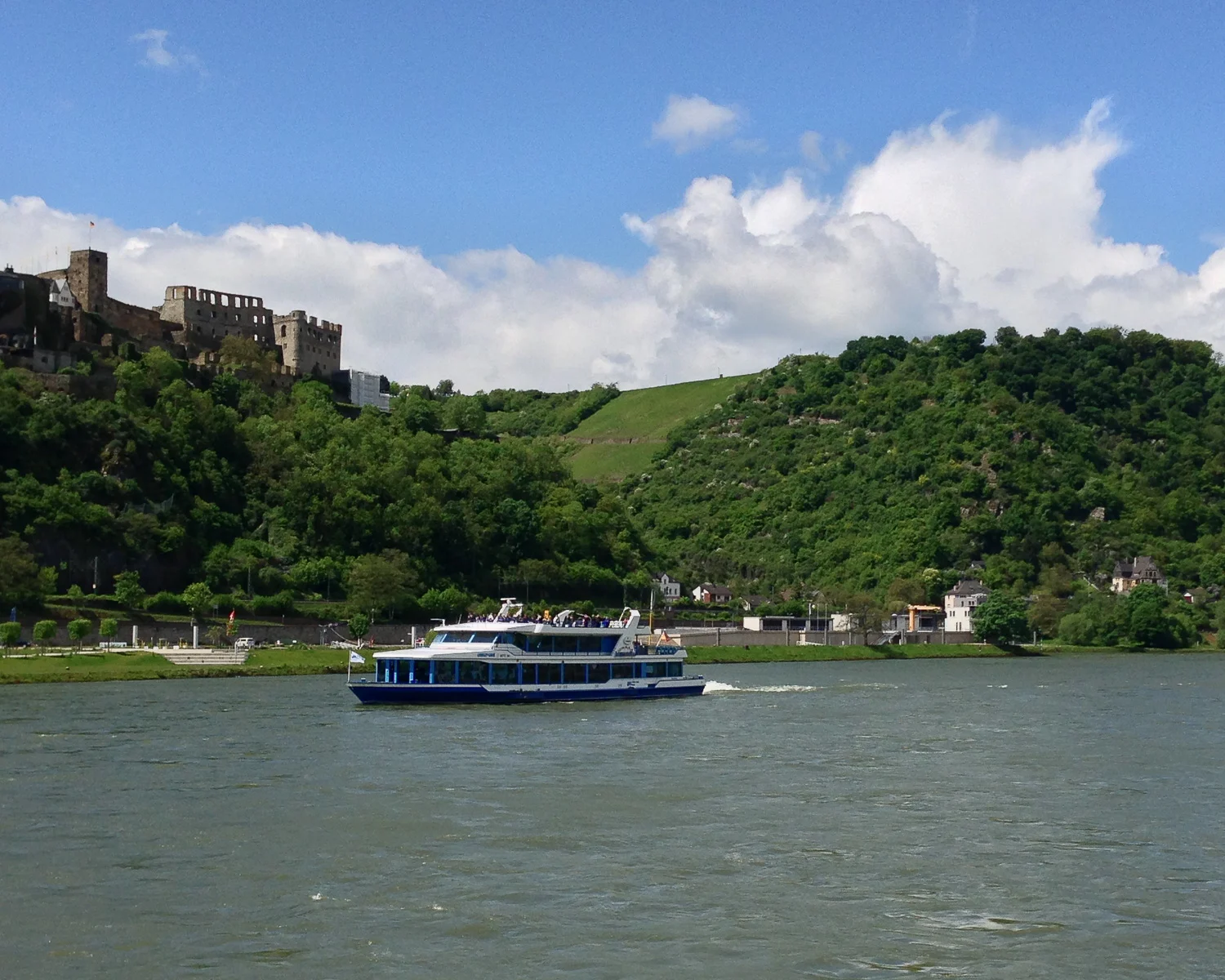
Rhine River cruise map
I partnered with The Online Travel Journal, who created the interactive Rhine River cruise map below to show all the places I visited on the cruise.
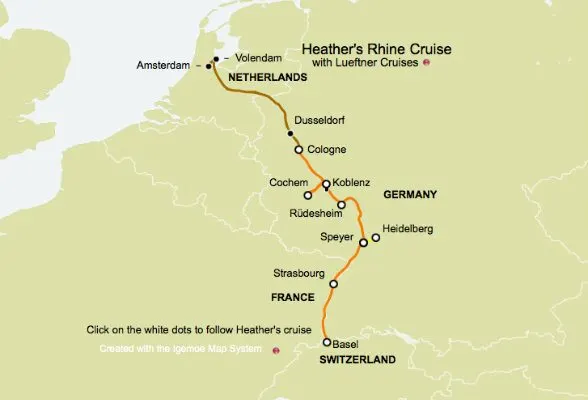
Rhine River map
Our cruise covered everything on the Rhine River map from the city of Strasbourg, the music museum at Rudesheim, wine tasting in Alsace to admiring the romantic castles and landscape of the Middle Rhine.
If you’re considering a Rhine River Cruise, the Rhine cruise map should give you a good feel for the places you might visit and things to enjoy. Click on the white dots to see more photos of the places we visited or read more about our trip below and at the Online Travel Journal.
Day 1 – Arriving in Basel
Exploring Basel
On arrival in Basel we made a short walk from the town centre along the river to meet our Lueftner Cruise ship, the Amadeus Princess. Since check in was at 4pm, we dropped our bags on board and wandered back along the river bank towards the centre of town.
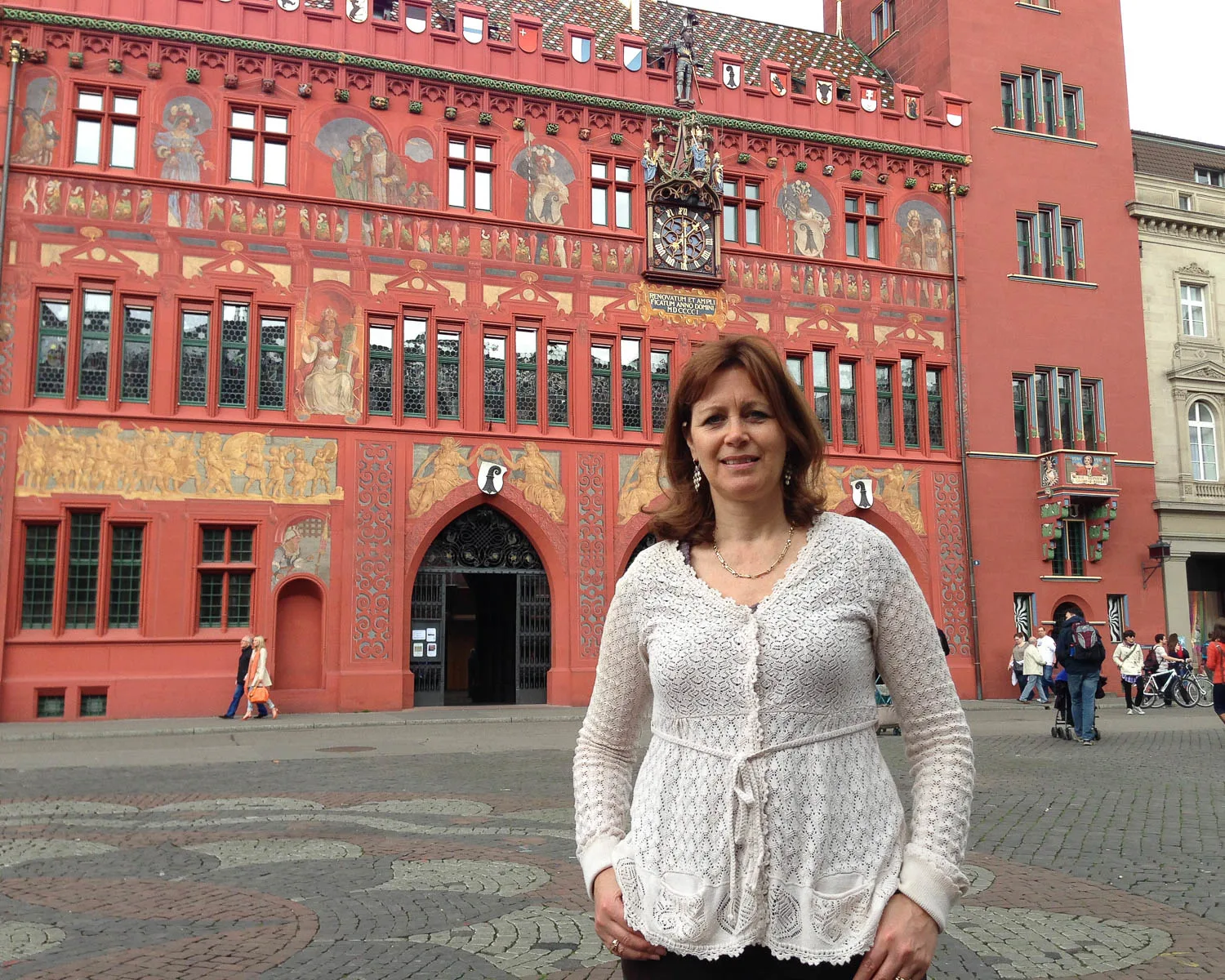
It being a public holiday in Basel, all the shops were shut which was a shame as I was tempted by the displays of delicious looking chocolate and marzipan in the Confiserie Schiesser.
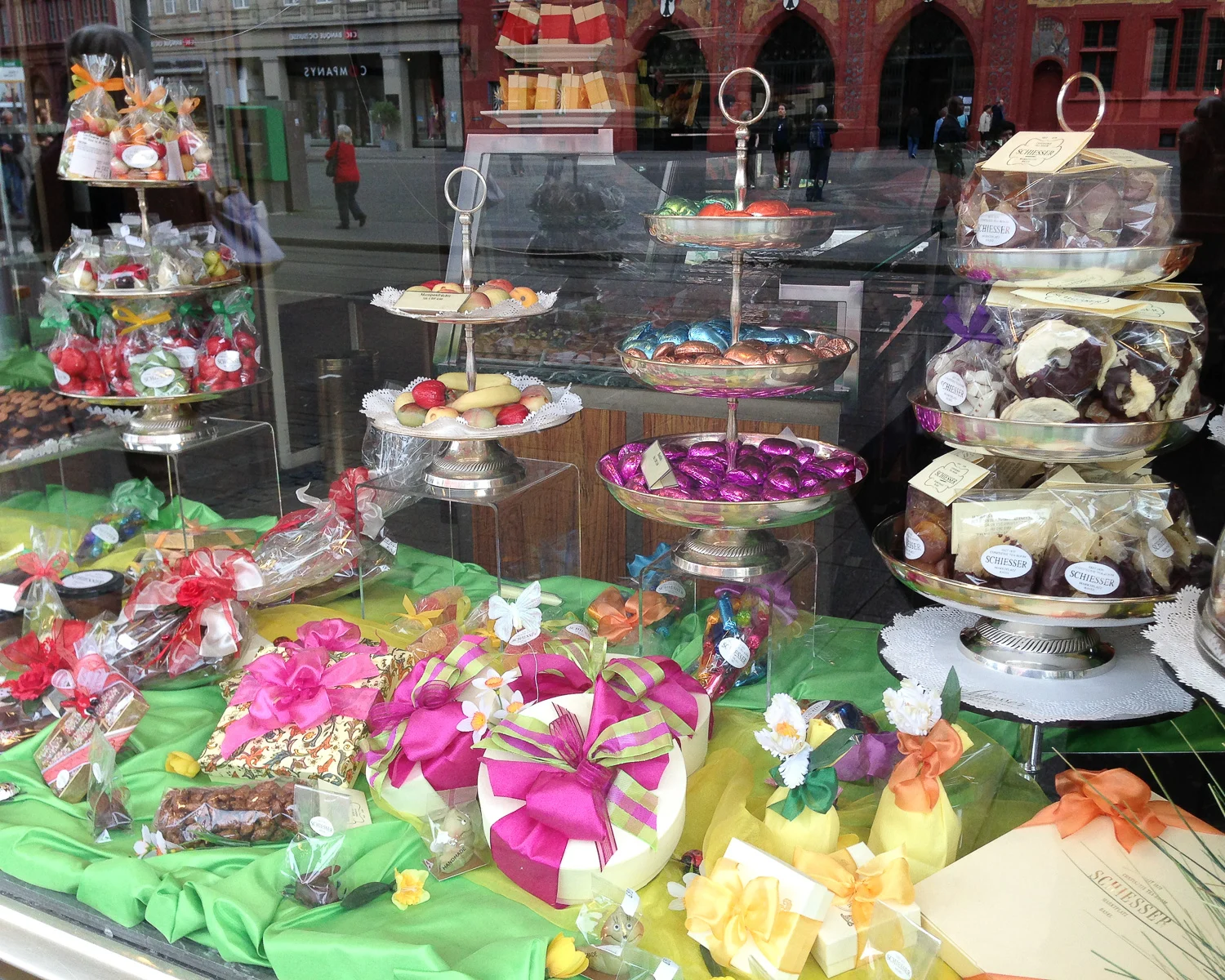
Sightseeing in Basel town centre
In the main square we admired the attractive facade of the 16th century Basel City Hall or Rathaus. Within the internal courtyard we found the walls covered with classical frescoes on the theme of law and justice.
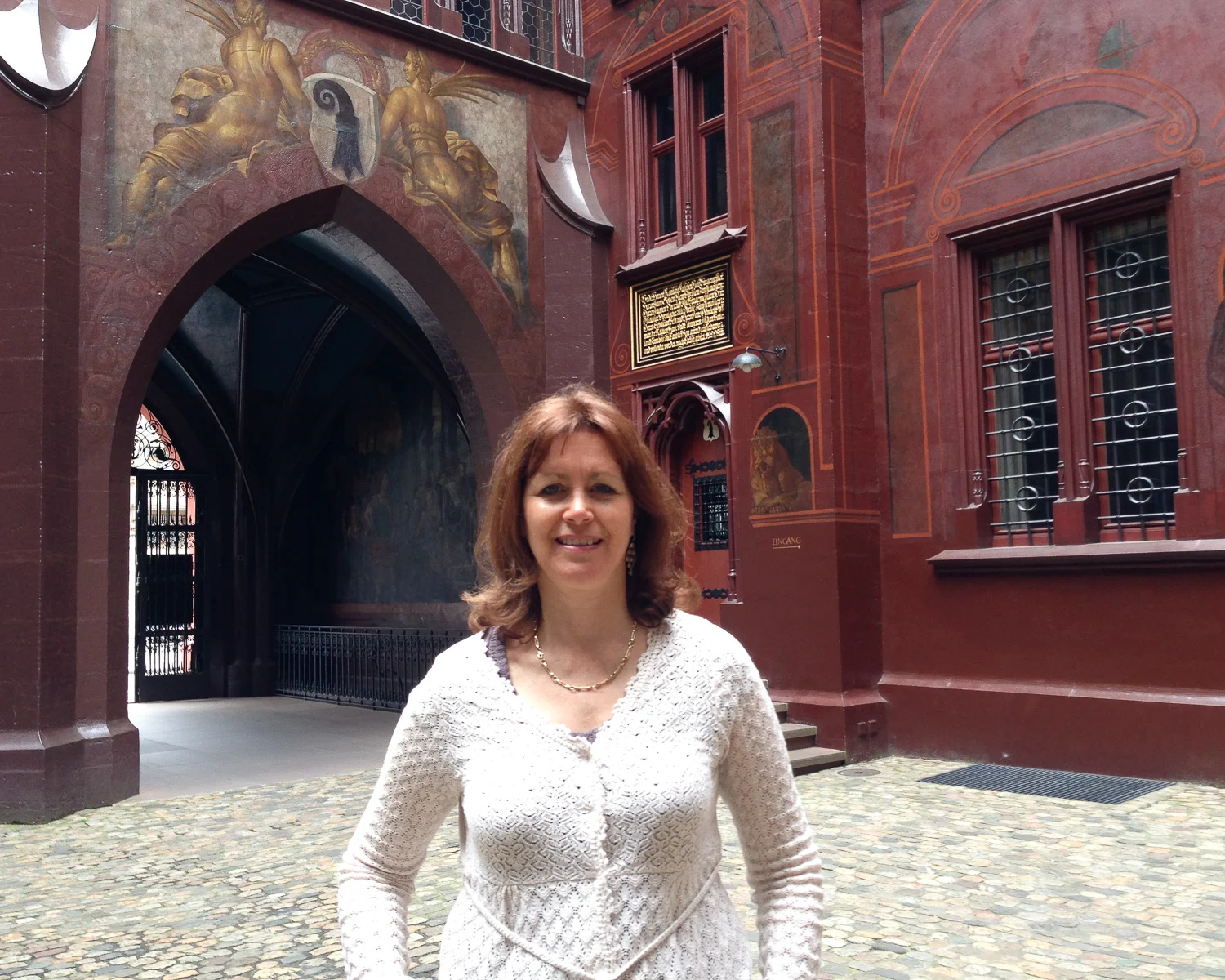
By now we were ready for a coffee but since nothing seemed open, we wandered around the narrow lanes of the old quarter. Passing the picturesque half timbered houses, we arrived at the large cathedral square.
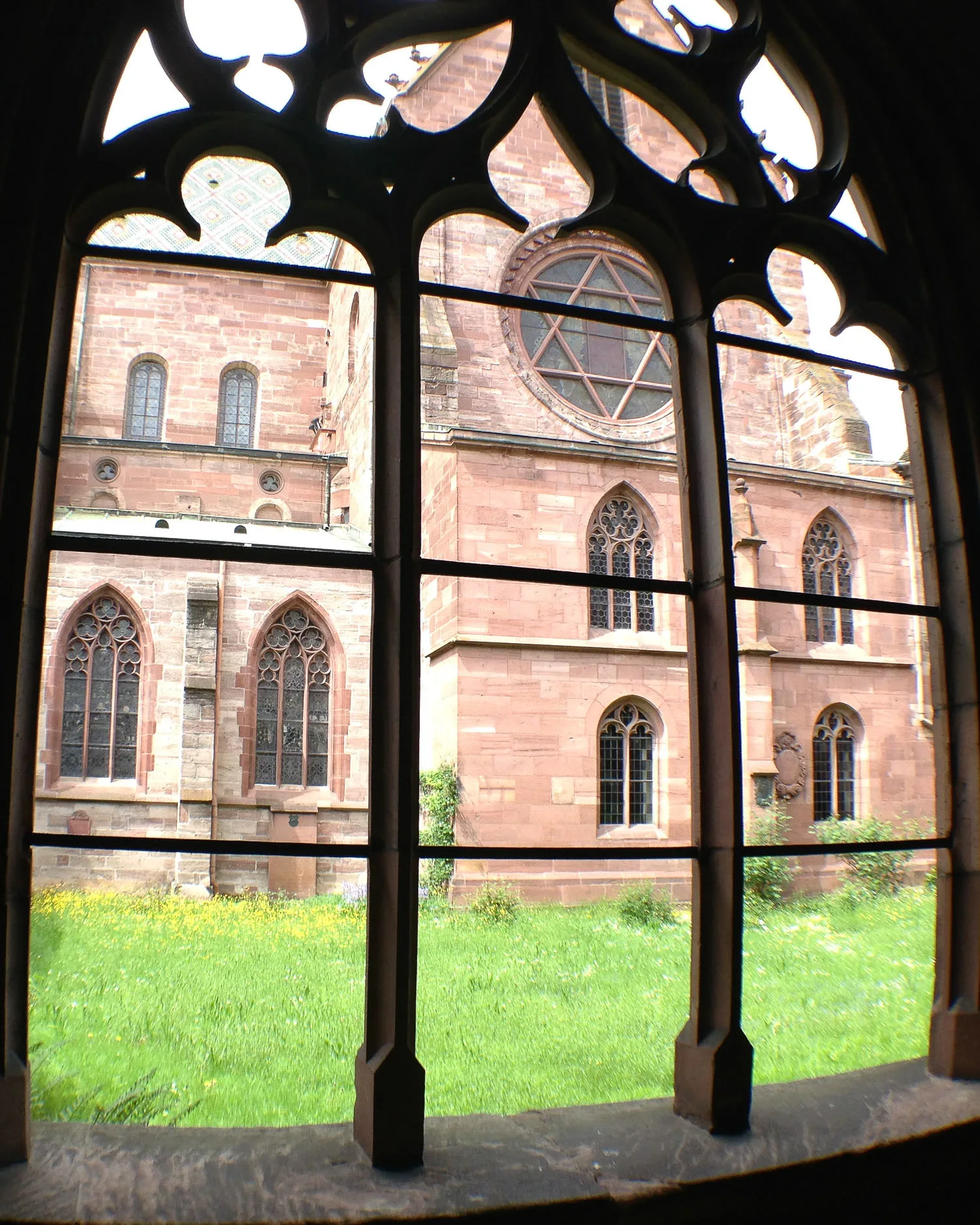
The café of the Museum of Culture was open for coffee and cake, with an interesting sculptural roof in contrast to the older buildings all around. A fountain played in the museum’s courtyard and as we walked more around Basel we started to notice fountains everywhere, as well as many public sculptures.
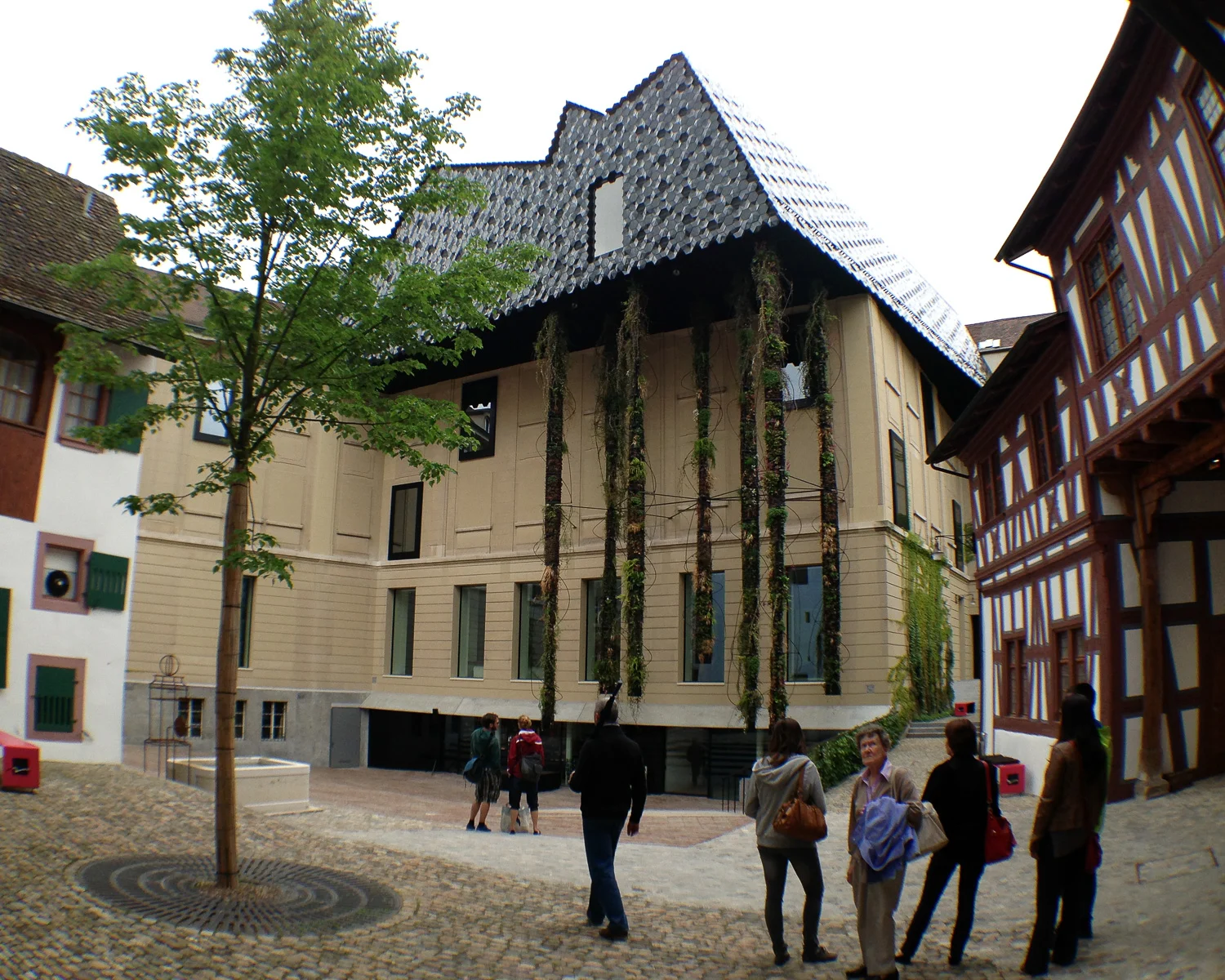
A group of friends played boules in the shade and within the cloisters of the cathedral was what looked like a wildflower meadow. Our impression of Basel was a civilised and artistic city, with bicycles everywhere. The Rhine is at the heart of the city and evidently clean enough for swimming, since we saw platforms on the river for summer swimming.
Checking in for our Rhine River Cruise
By now it was time to return to the Amadeus Princess and check in. We found our cabin, which was compact but comfortable with plenty of storage. Late in the afternoon there was a safety briefing and then a captain’s welcome cocktail, before we enjoyed our 5 course meal in the restaurant washed down by local wines.
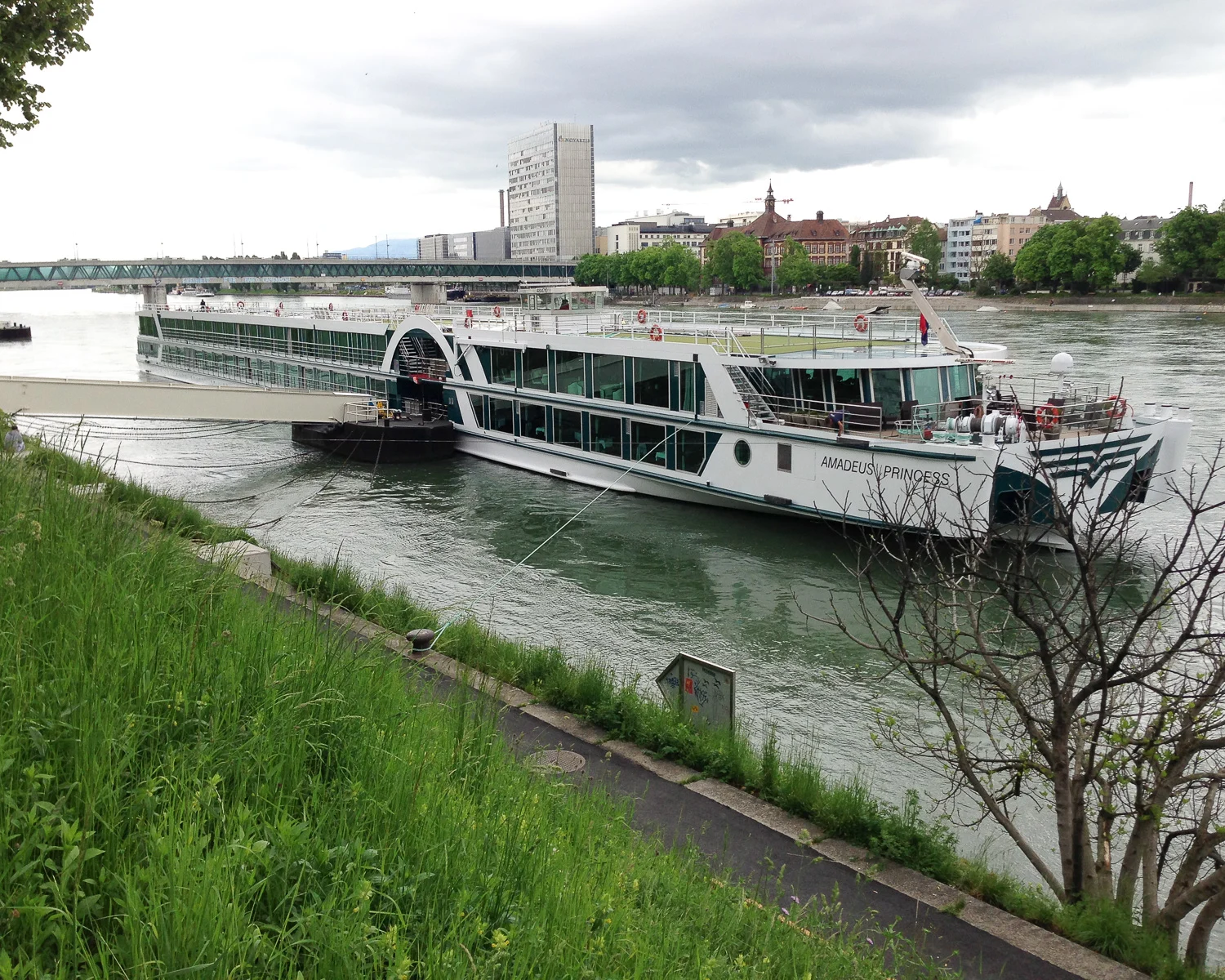
Day 2 – Strasbourg and the Alsace Wine Road
Our first stop was in Strasbourg, to explore the city and do a wine tasting tour.
A morning tour of Strasbourg
On our tour of Strasbourg, we learned so many fascinating things from our guide’s commentary. Passing through the diplomatic quarter we spotted the nests of the storks are the symbol of the city, perched like hats on top of the pollarded lime trees.
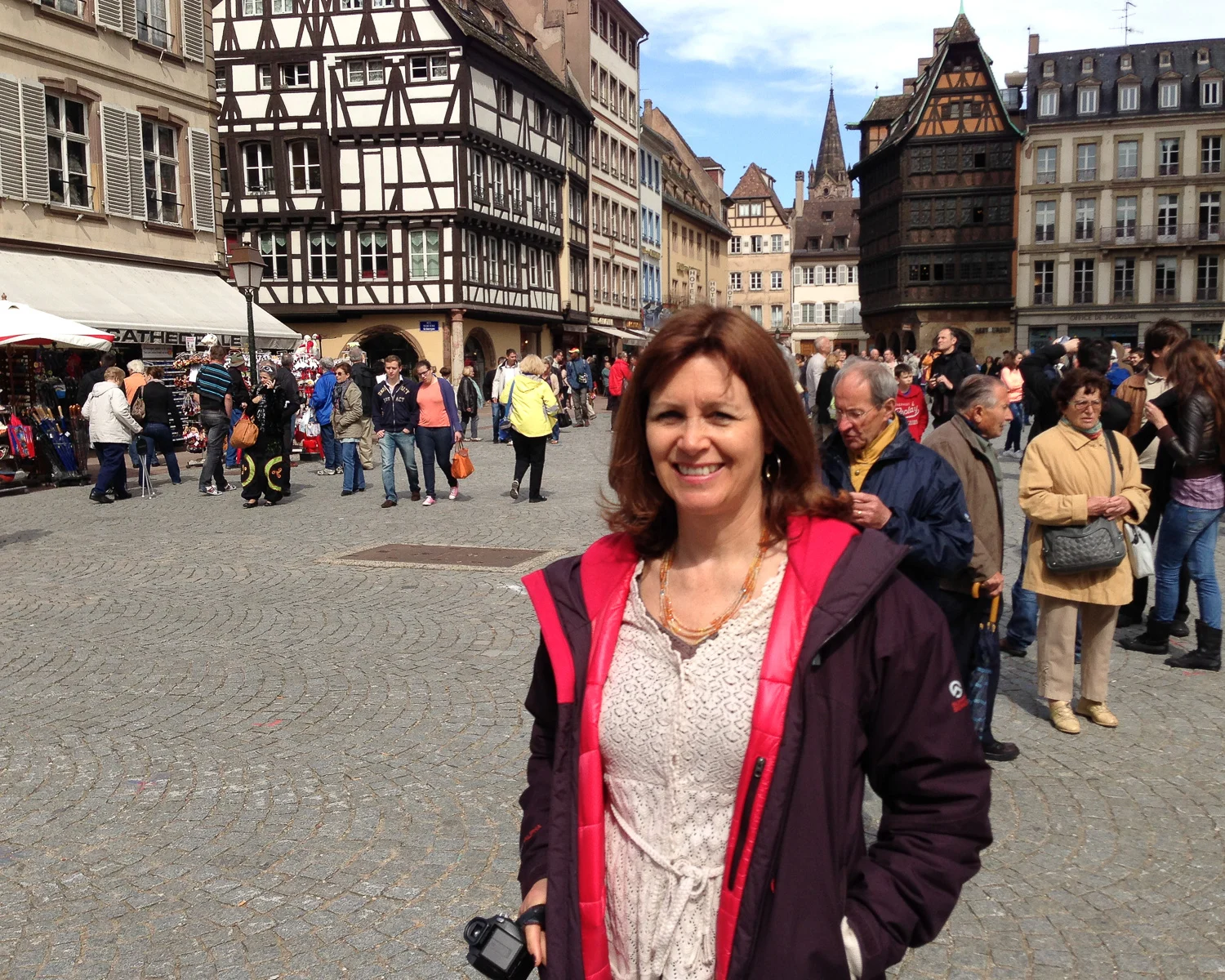
In the 1970s they had almost disappeared from the region, but now there are over 400 in Alsace. Of course everyone knows that if you leave a piece of sugar out for the stork it will bring you a baby!
We also learned that Strasbourg has switched from France to Germany many times in its history, being on the border of the two countries. The statue of Mother Alsace mourning over her two dead sons killed in action, commemorates a time when families might have brothers from the same family fighting against each other in the French and German armies.
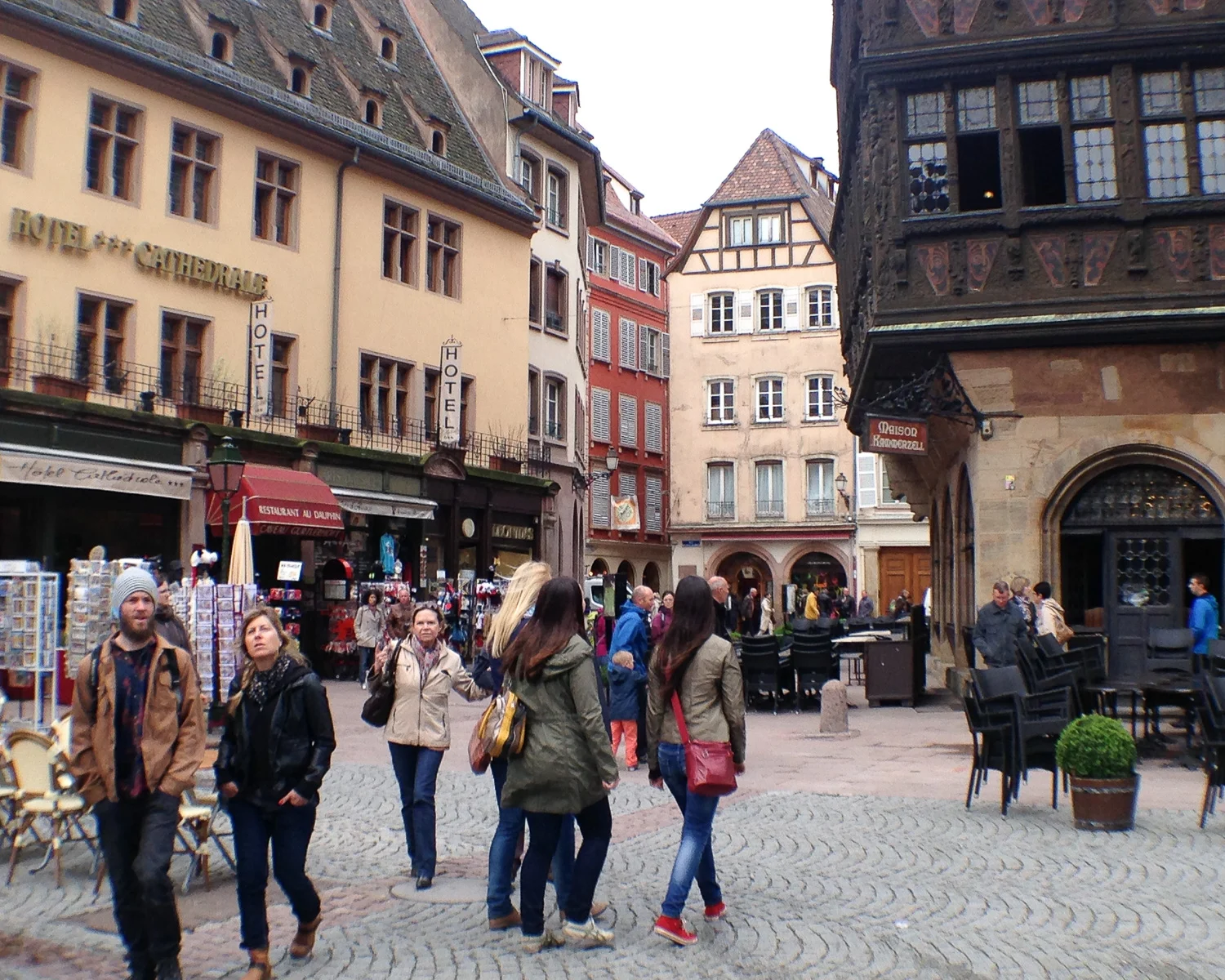
No wonder that the people of Strasbourg believe so strongly in peace and host the Conseil de l’Europe to ensure that there is never another war in Europe.
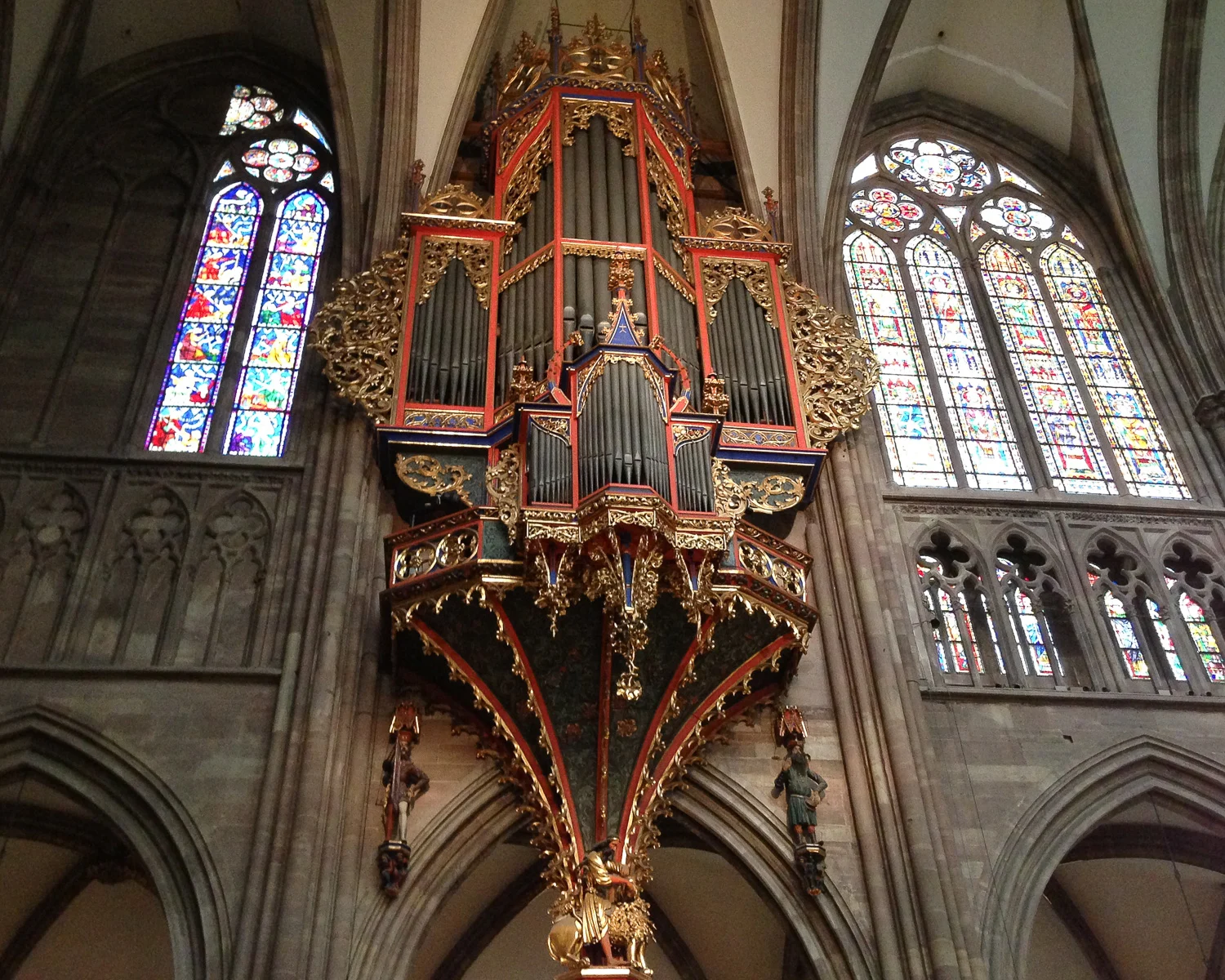
Our coach dropped us in the historic town centre, with its half-timbered houses. We explored the cathedral where the stained glass windows had all been cleaned to make their colour extra bright. Our morning in Strasbourg ended with a boat trip with guided commentary through the Petite-France area of rivers and canals, with view from the water of many more beautiful old houses.
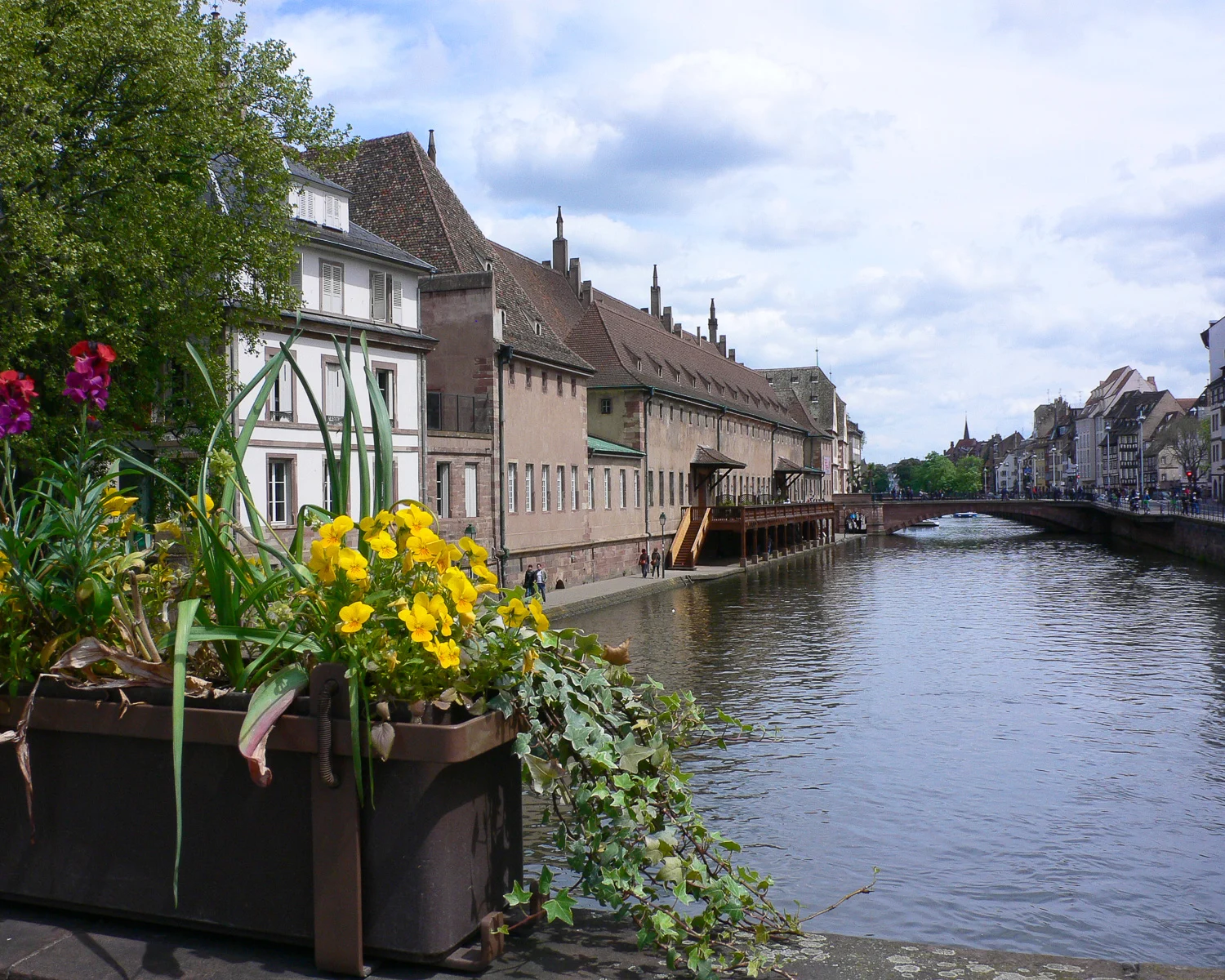
The Alsace Wine Road
After lunch back on the Amadeus Princess, we boarded the coach once more for an afternoon excursion. Our object was a wine tasting on the Alsace wine route, that runs through the rolling foothills of the Vosges mountains.
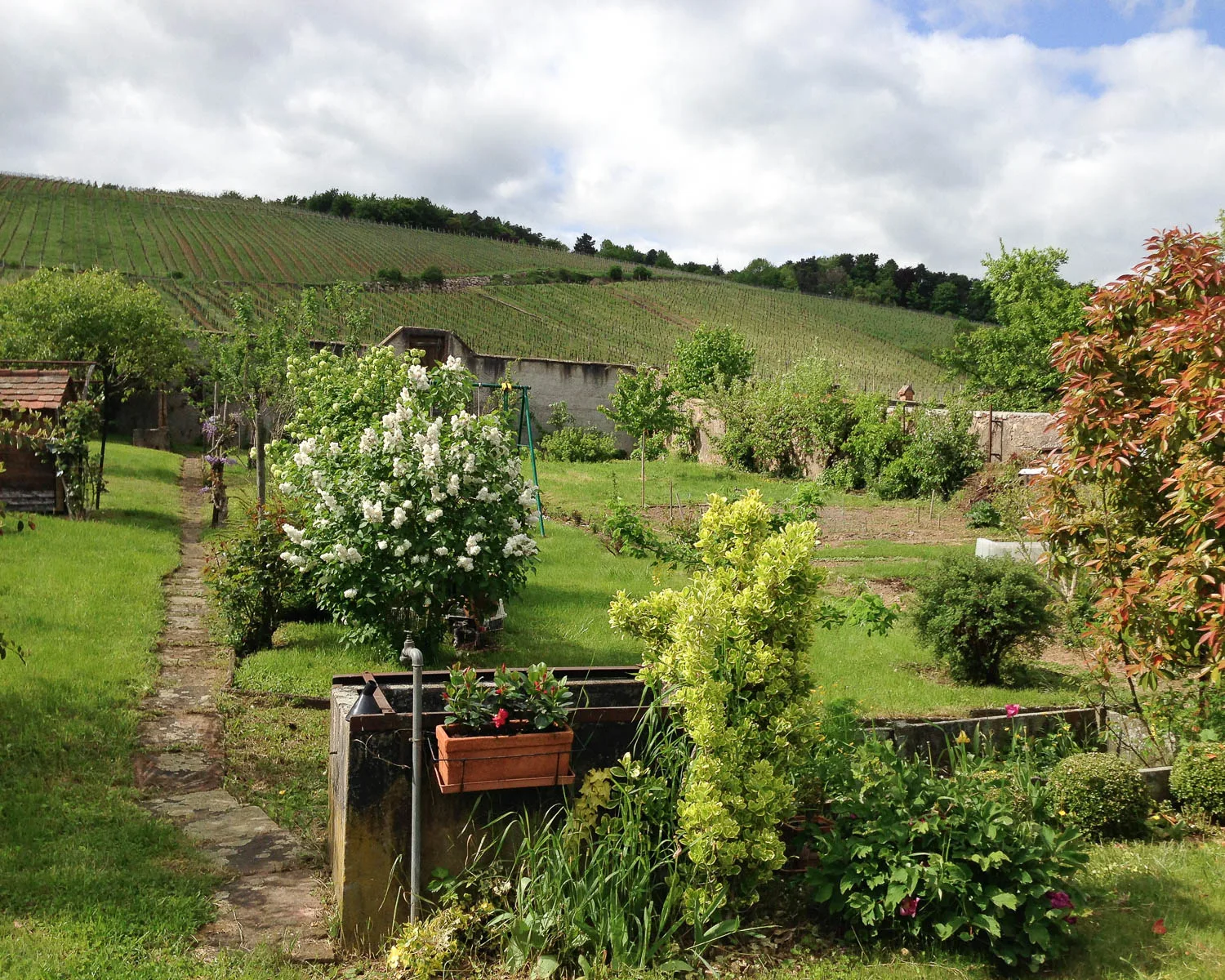
First stop was at Domaine Hering where we passed through the cellars to see the steel vats and enormous oak barrels used to age the wine. Back upstairs, we learned about the six different kinds of Alsace grapes and tasted the Pinot Gris, Reisling and Gewurtztraminer. I also spotted that they make a Cremant d’Alsace, the local equivalent of Champagne but half the price.
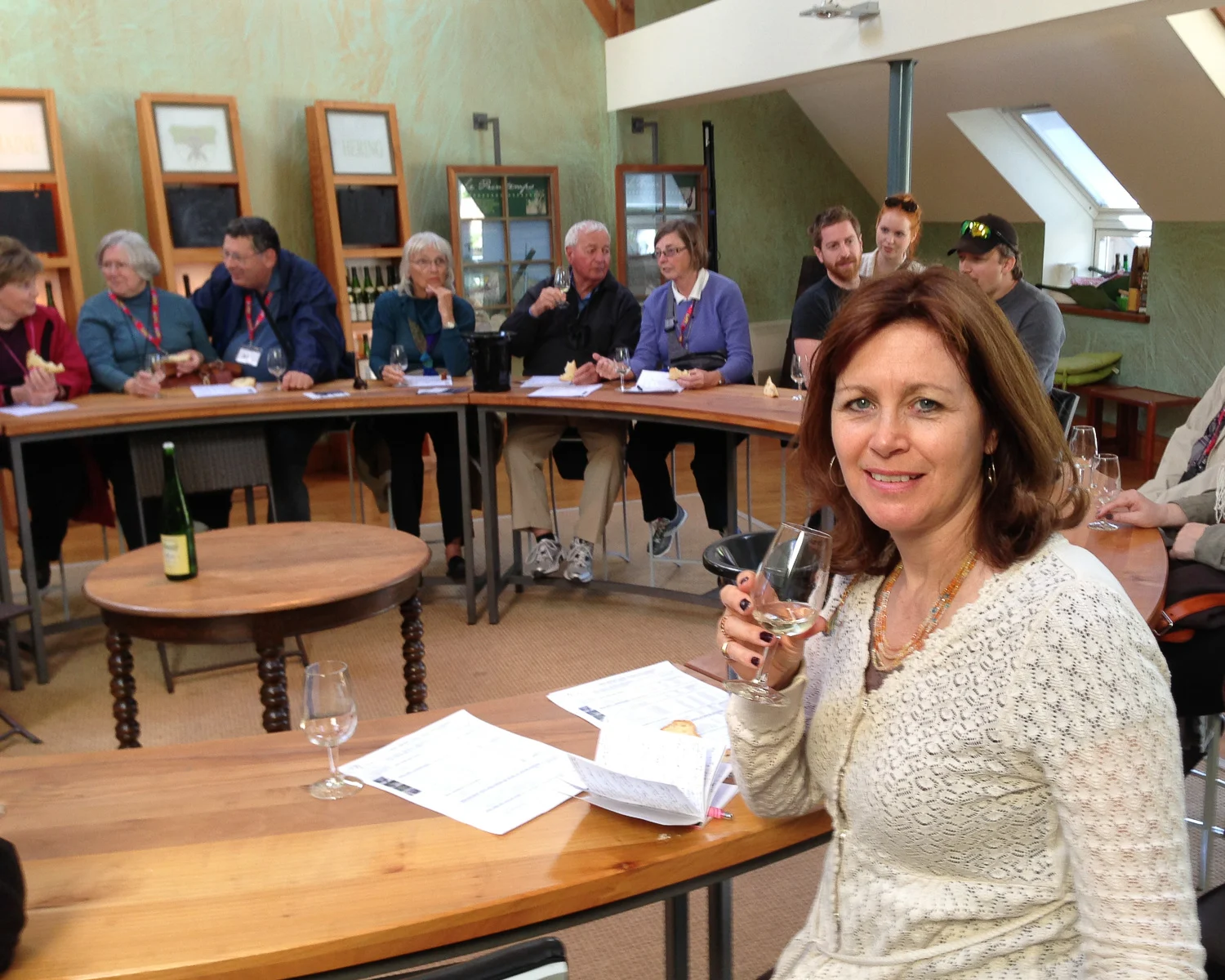
Our route back to the Amadeus Princess included a stop at the pretty small town of Obernai. The town is bounded by the river and old ramparts, designed to protect the wealth of the town that came from its wine.
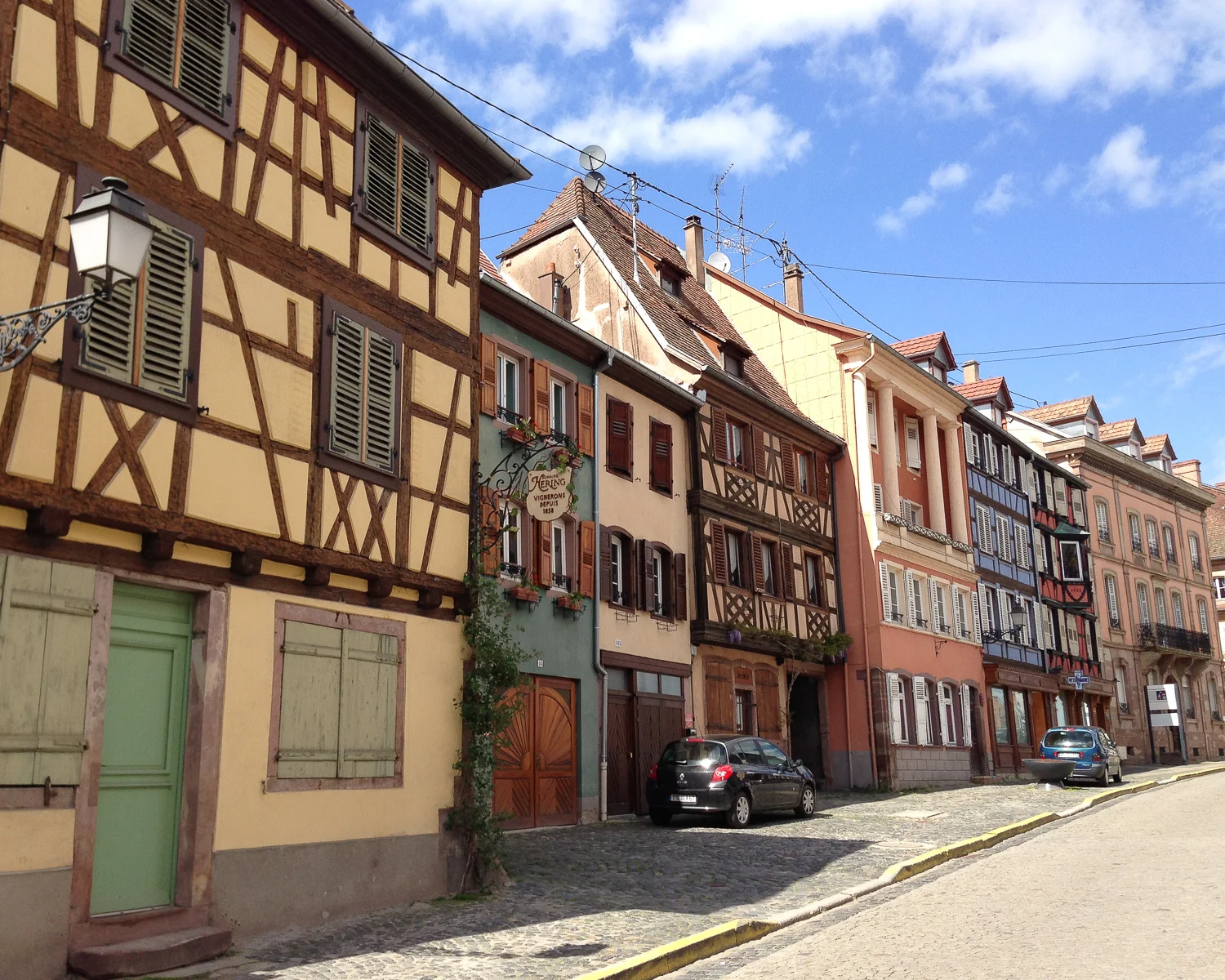
Day 3 – Speyer and Heidelberg
By morning we arrived in the small town of Speyer, with a visit to the university town of Heidelberg in the afternoon.
A morning tour of Speyer
The Amadeus Princess moored in Speyer, just a five minute walk from the small town with a very big Romanesque Cathedral. In past centuries the town had a large Jewish population who were invited here by the German Emperors to oil the wheels of commerce.
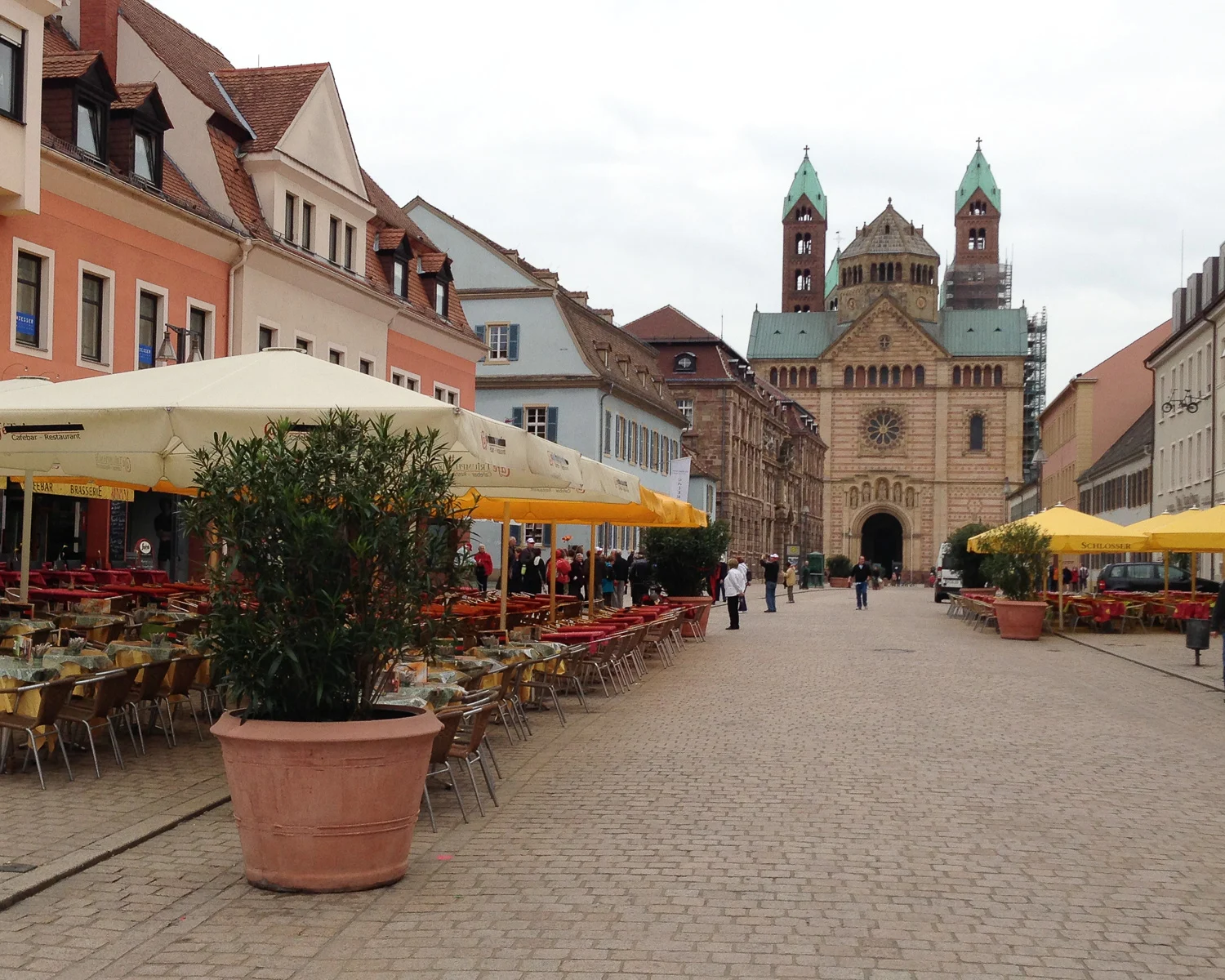
The first stop on our walking tour was a look around the medieval Mikveh or Jewish baths, used for ritual purification, where the water of heavens (rainwater) and earth (groundwater) mingled. Our walk continued to the Lutheran Trinity church where we admired the beautifully decorated roof and gilded altar to the accompaniment of an organist who was practicing for a wedding.
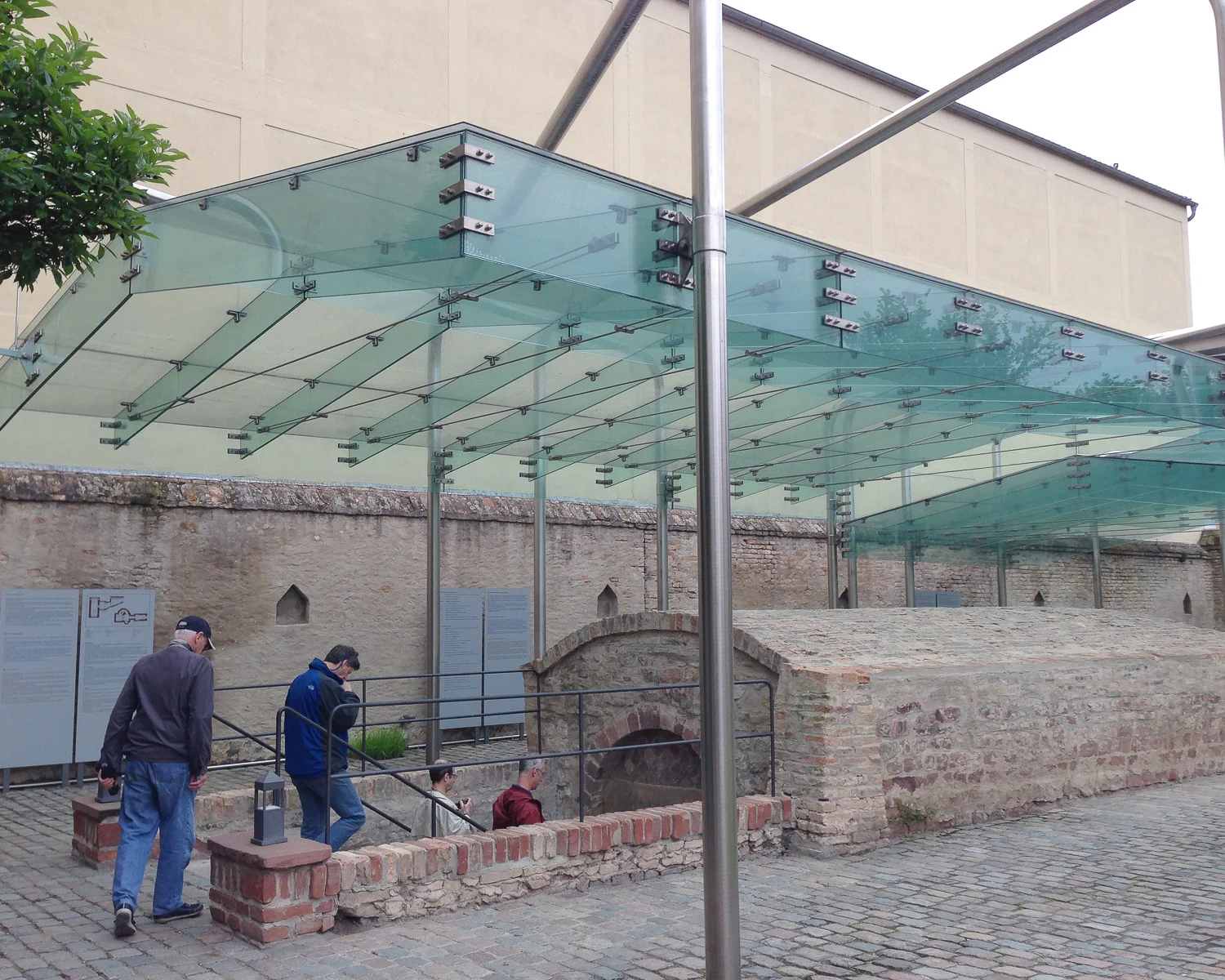
Speyer Cathedral
Finally we visited the cathedral with soaring pillars built of the local red sandstone. Within its crypt are buried many of the kings and emperors of Germany from the 12th century. On seeing the huge stone coffins I marvelled how they had managed to manoeuvre these heavy blocks of stone into the narrow niches where they now sat.
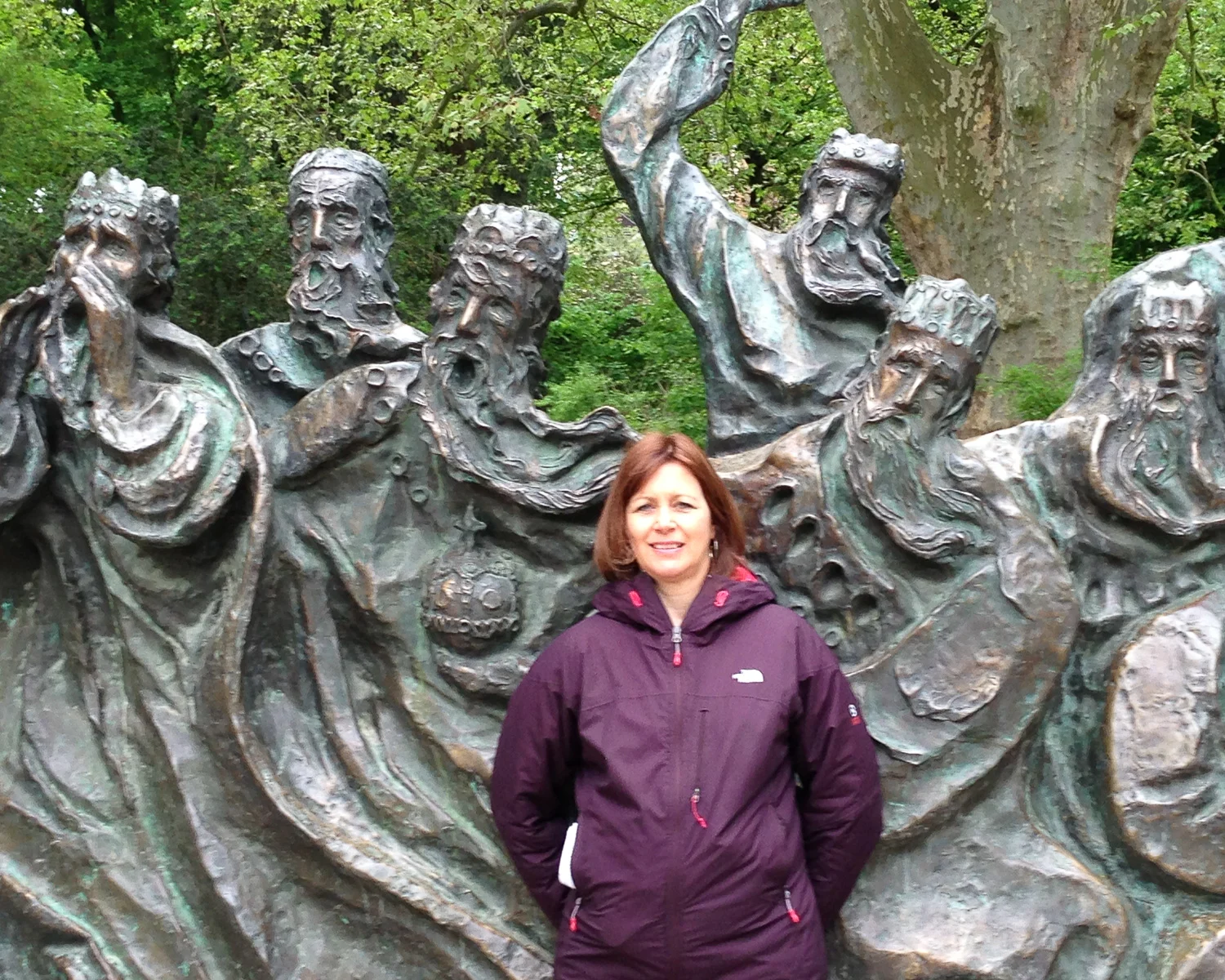
At the front of the cathedral we noticed a stone bowl 2 metres wide and learned of the custom that each new bishop had to fill it with wine for the people of Speyer as part of his inauguration.
A tour of Heidelberg castle
After lunch back on the ship we took the coach for our afternoon excursion to the famous university town of Heidelberg, which escaped bombing during the Second World War. A ruined castle on the hill gives the town a romantic aspect and our first walk was around its courtyards and stone facades carved with statues and pillars.
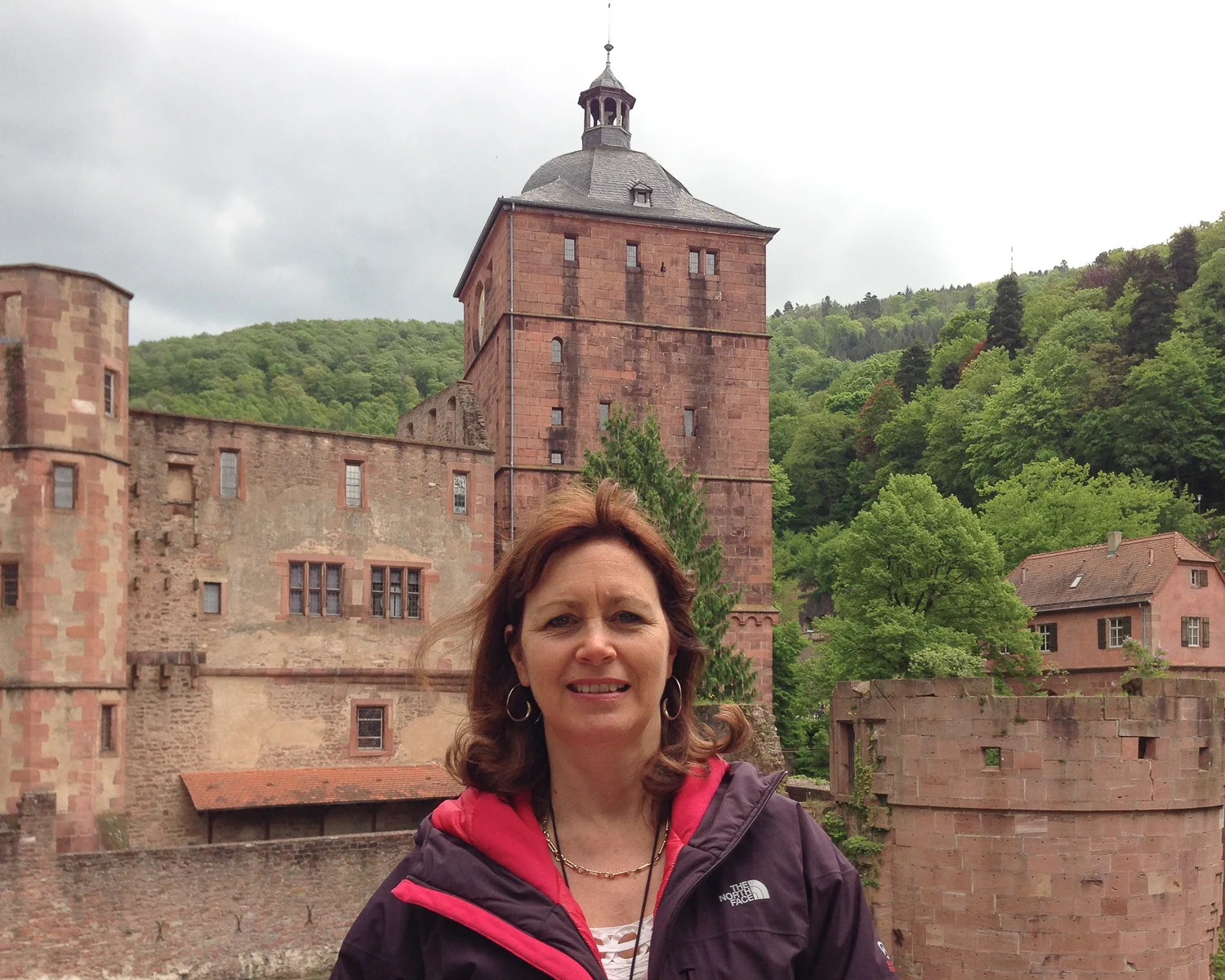
From the castle terraces we had a bird’s eye view over the red tiled roofs of the town with two churches and the old stone bridge across the Neckar river. In the castle cellars we found an enormous wine cask, but just around the corner was an even bigger one, with a stairway leading to the top where there was a small platform once used for dancing.
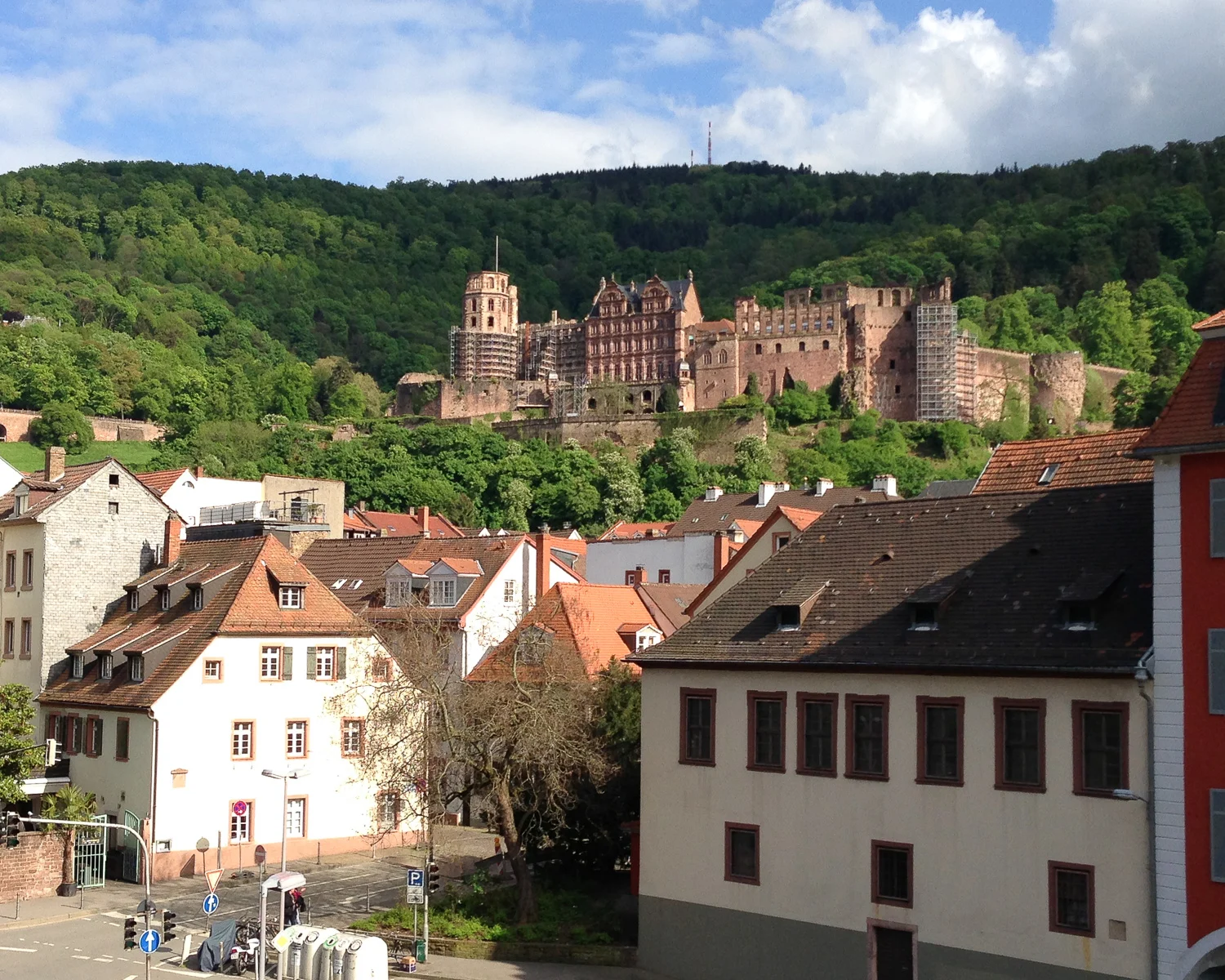
A walk around Heidelberg
Driving back down to the town centre, our guide pointed out to us several houses decorated by flags. These are owned by wealthy fraternities of university students who gather (men only!) to drink as much beer as possible and practice sword fighting.
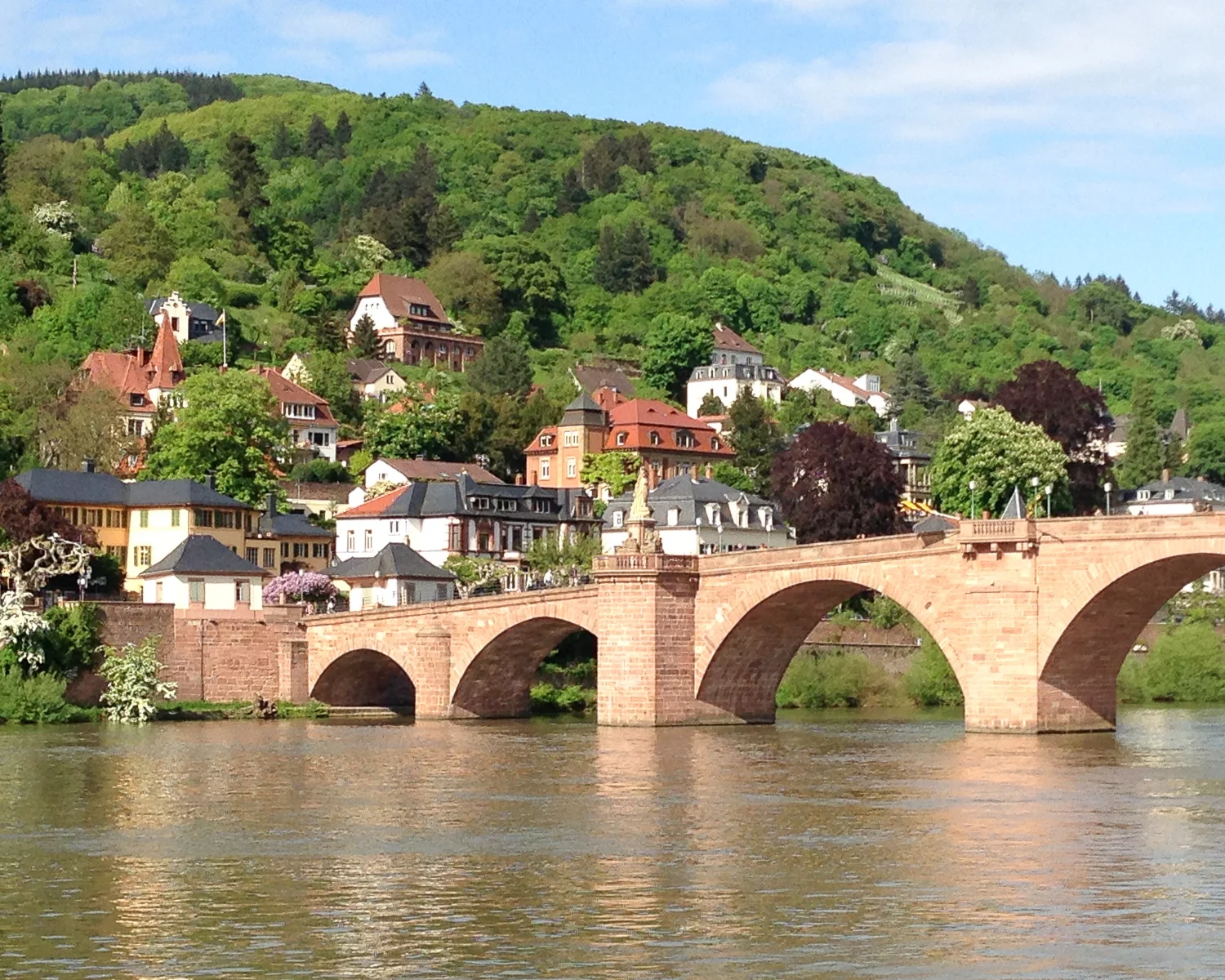
We enjoyed our walk around the pedestrianised centre of the town with plenty of cafes and beer gardens. Near the old stone bridge were the marks of the water levels in past centuries when the town had flooded.
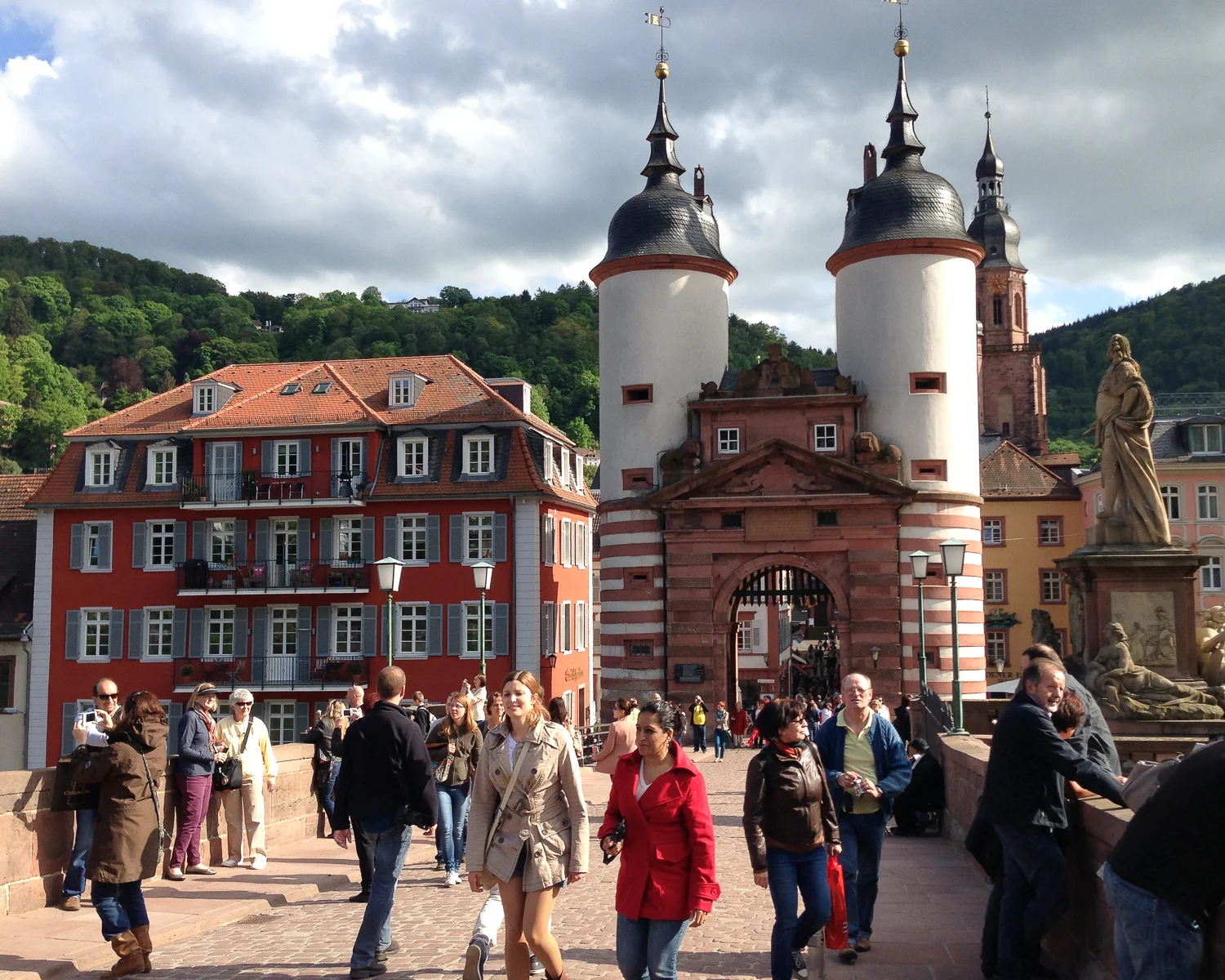
We came across Kathe Wohlfahrt, a shop devoted entirely to Christmas decoration as well as a room full of cuckoo clocks, and chose a wooden tree decoration to take home.
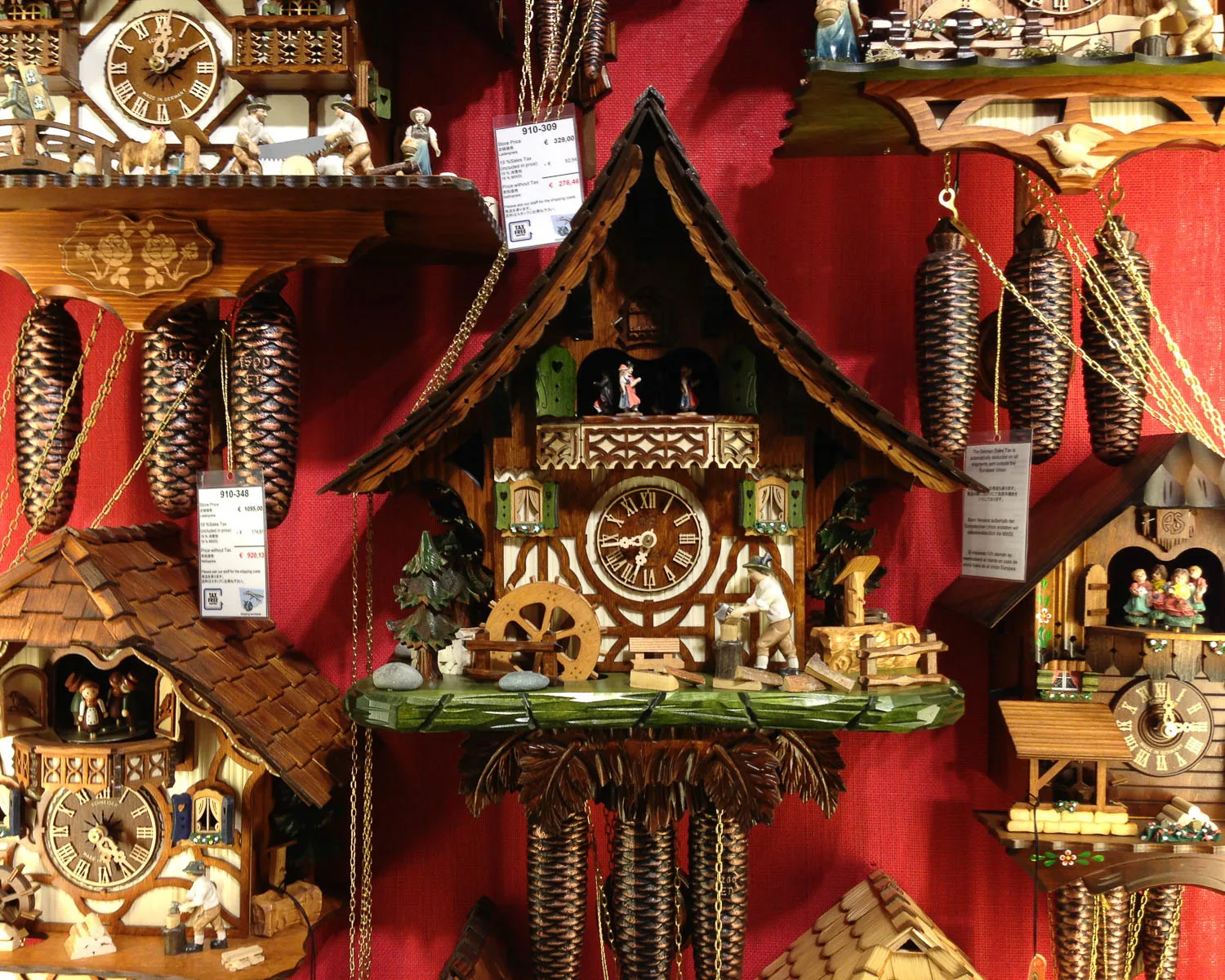
Finally we stopped for a coffee at the Gundel café, where I tried their special Kurfürstenkugel cake. This sponge ball filled with cream and covered with chocolate, was created in the 17th century, in honour of Prince Frederick V and his wife Elizabeth Stuart, daughter of the king of England.
Day 4 – Rüdesheim, the castles of the Middle Rhine and Koblenz
After a visit to the charming town of Rüdesheim, we cruised through the romantic Middle Rhine Valley, past castles and vineyards, arriving at Koblenz.
A morning walk in Rüdesheim
Our day began in Rüdesheim with a walking tour of this charming small town, the highlight of which was the music museum. An old manor house houses a collection of mechanical musical instruments, bought and restored by Siegfried Wendel, with everything from a colourful fairground organ to a tiny music box.
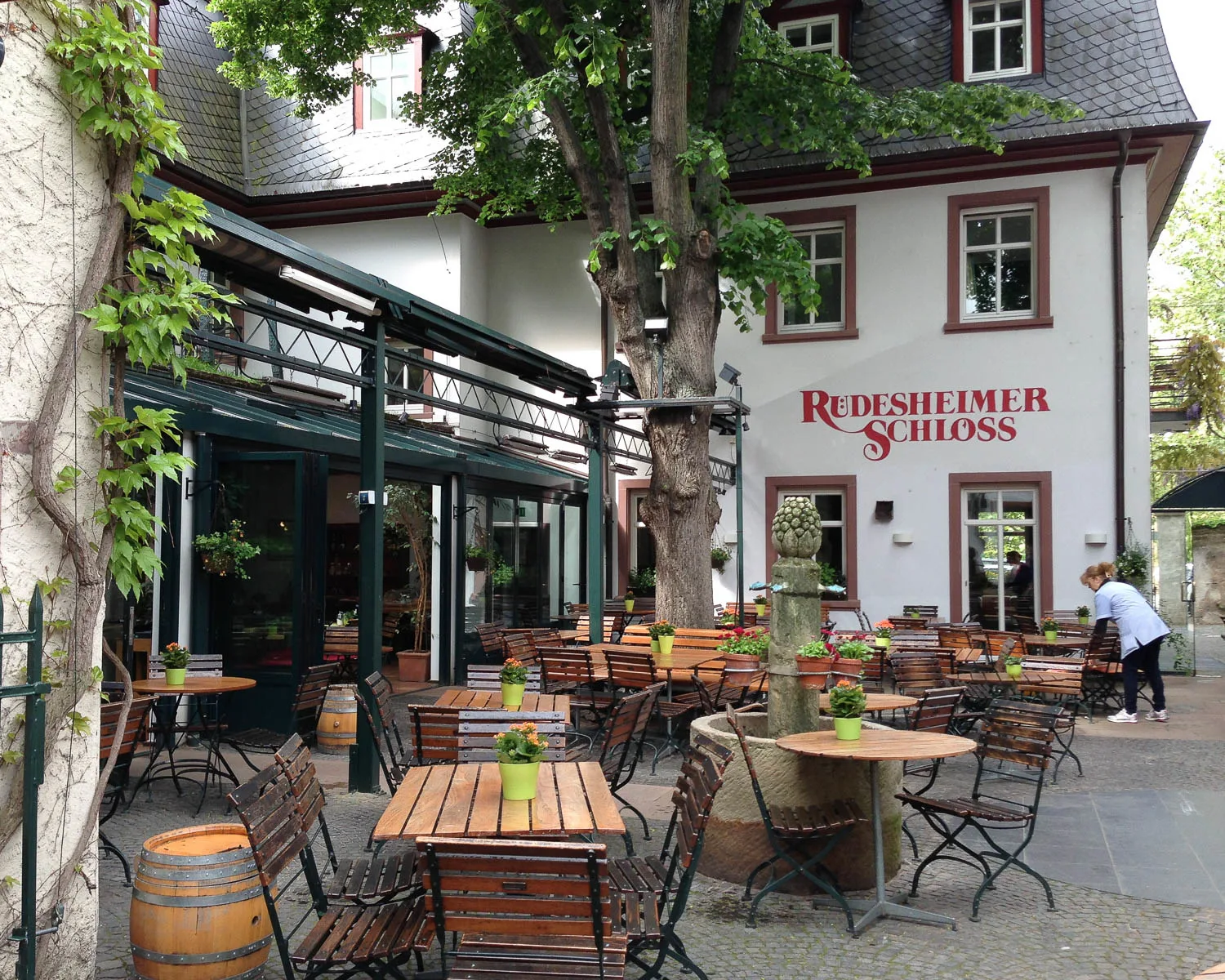
As we walked through each room, the guide set each of the instruments to play in turn, including a phonograph invented by Thomas Edison. It required a fresh needle to play every record and had no volume control, resulting in the expression, ‘put a sock in it’, as this was exactly what they did to turn the sound down.
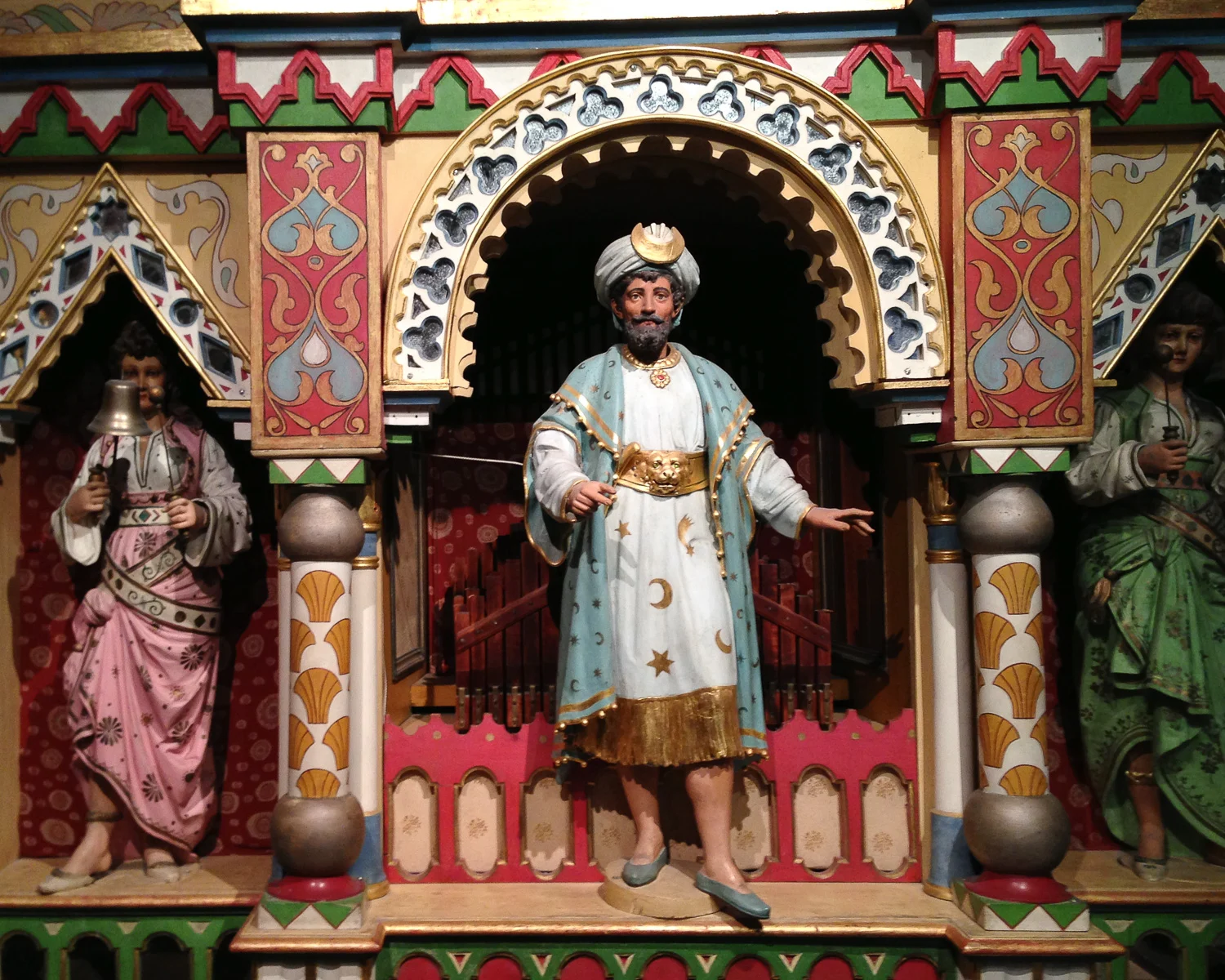
Our walk continued around Rüdesheim, down a narrow street filled with taverns and wine shops, known as the Drosselgasse. We couldn’t resist to try the local specialty of a Rüdesheimer coffee, a delicious concoction of flamed brandy, mixed with coffee, topped with whipped cream and sprinkled with chocolate.
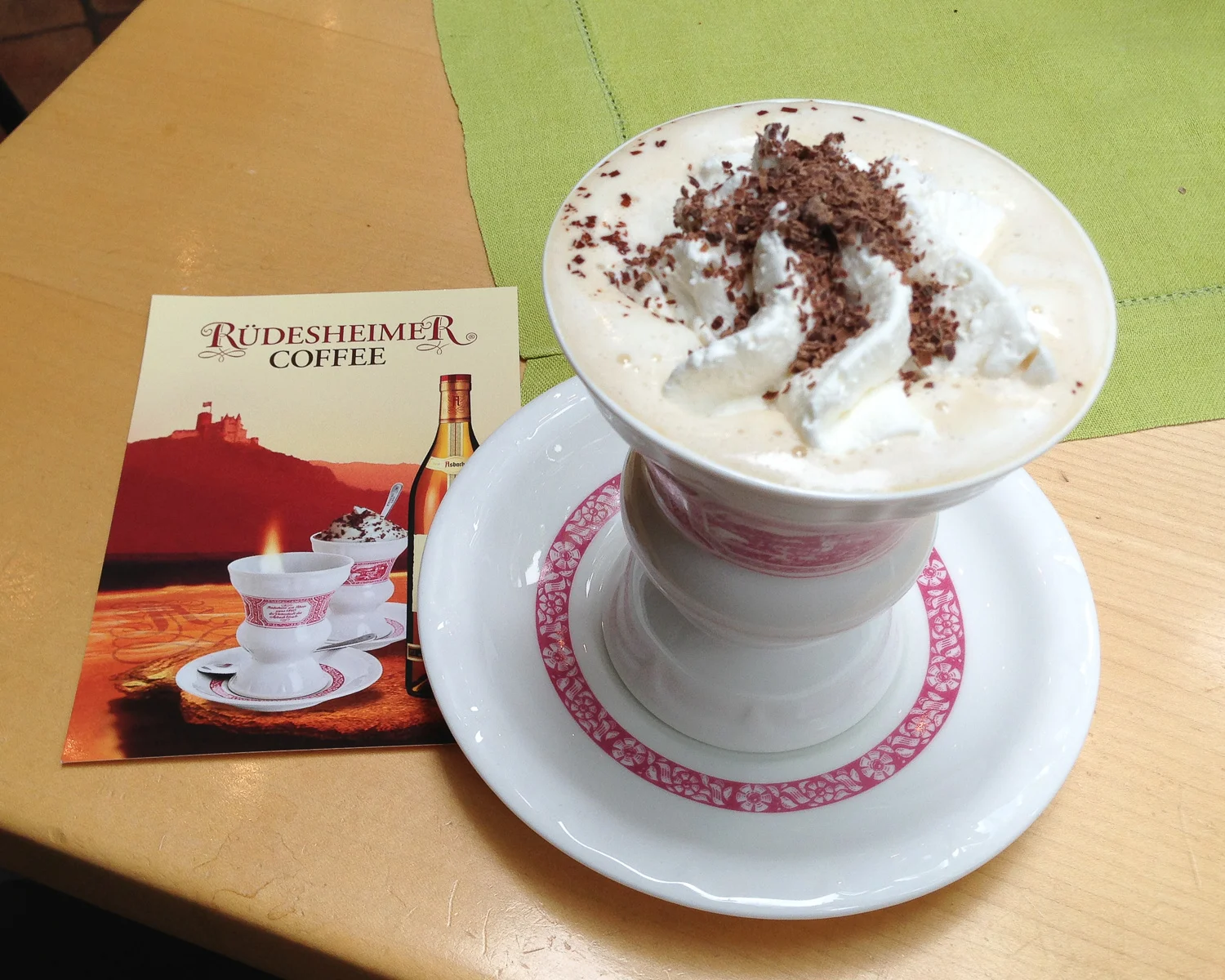
In the days when it was considered unseemly for women to drink in public, this was the way they could enjoy a secret tipple with their friends.
The Castles of the Middle Rhine
Later in the morning, the Amadeus Princess sailed from Rüdesheim, passing through the sloping vineyards and romantic scenery of the Middle Rhine valley. This area of the Rhine has many castles set high above the river that were built in the Middle Ages by local princes, in order to tax the merchandise being transported along the river.
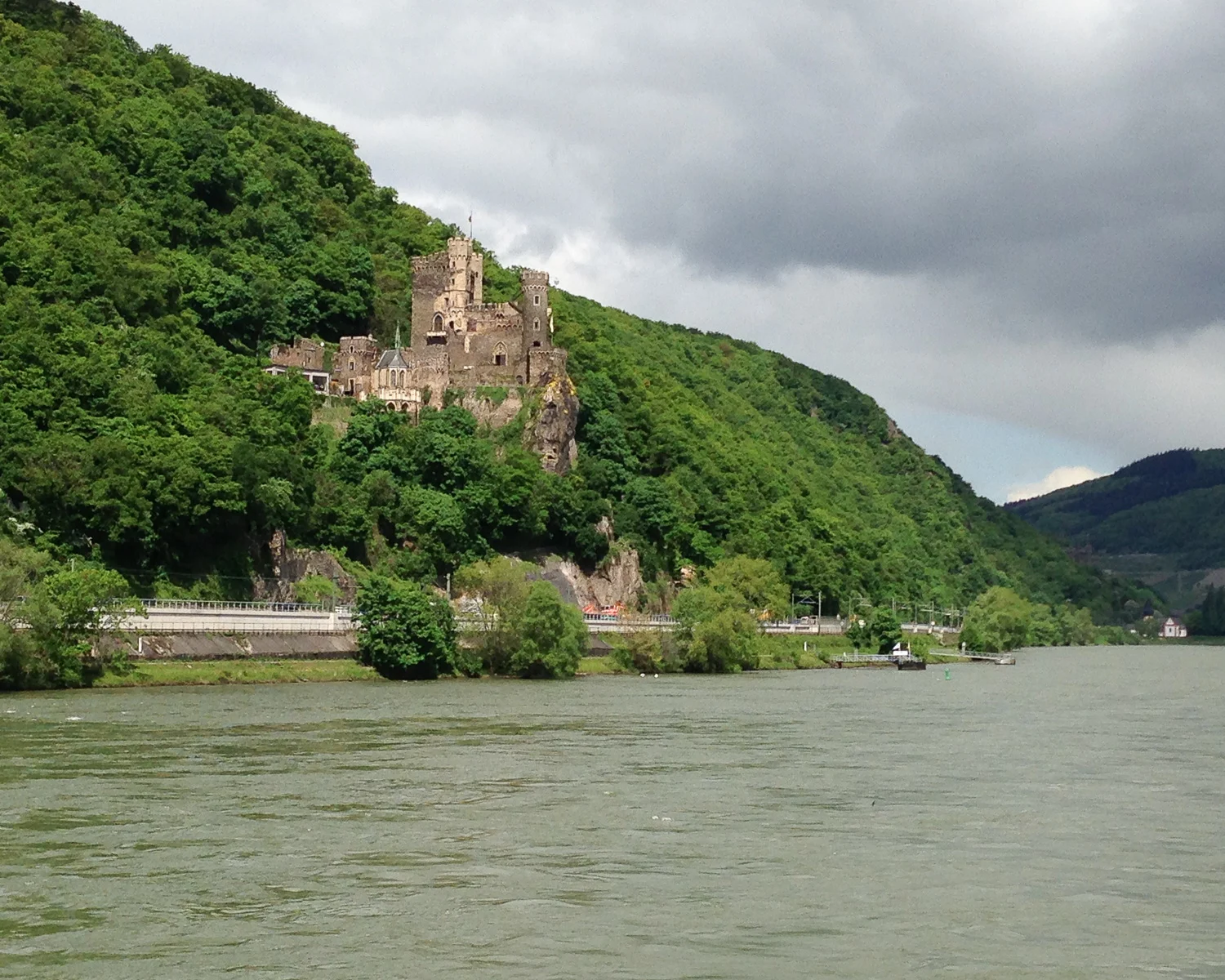
We passed the high cliff, known as the Loreley, where only a narrow channel of the river is navigable, causing many ships to founder at this point of the Rhine. The legend has it that a beautiful maiden sits on the rock, distracting the sailors with her singing, a bit like the sirens in the tale of Odysseus.
As our previous days had been busy with sightseeing, we really enjoyed the chance to relax on the top deck and enjoy the picturesque castles and scenery.
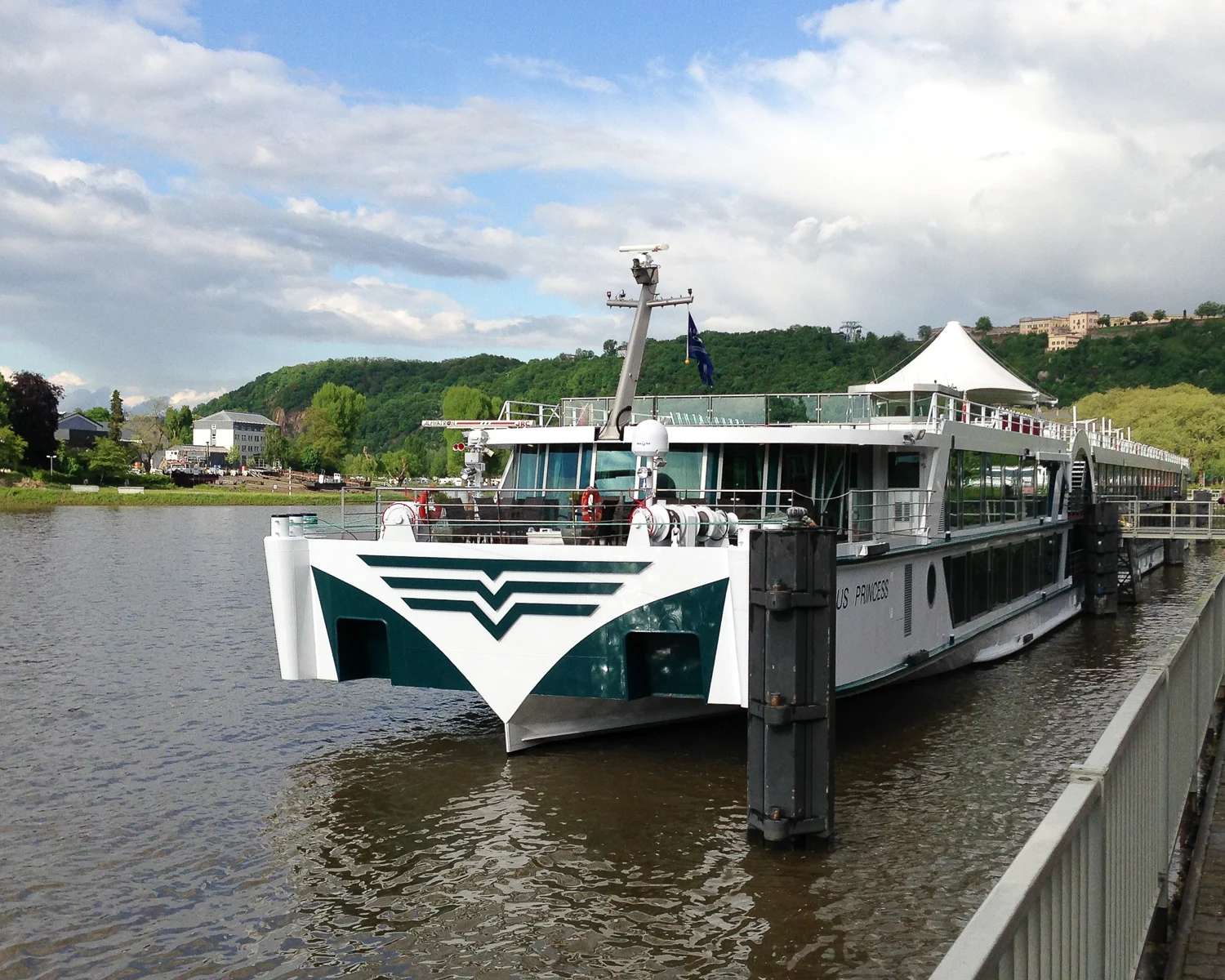
A tour of Koblenz
By the afternoon we reached Koblenz, named after the confluence of the rivers Moselle and Rhine. Over 80 percent of the town was destroyed by Allied bombing in the Second World War. The retreating Germans finished the job by blowing up all the bridges.
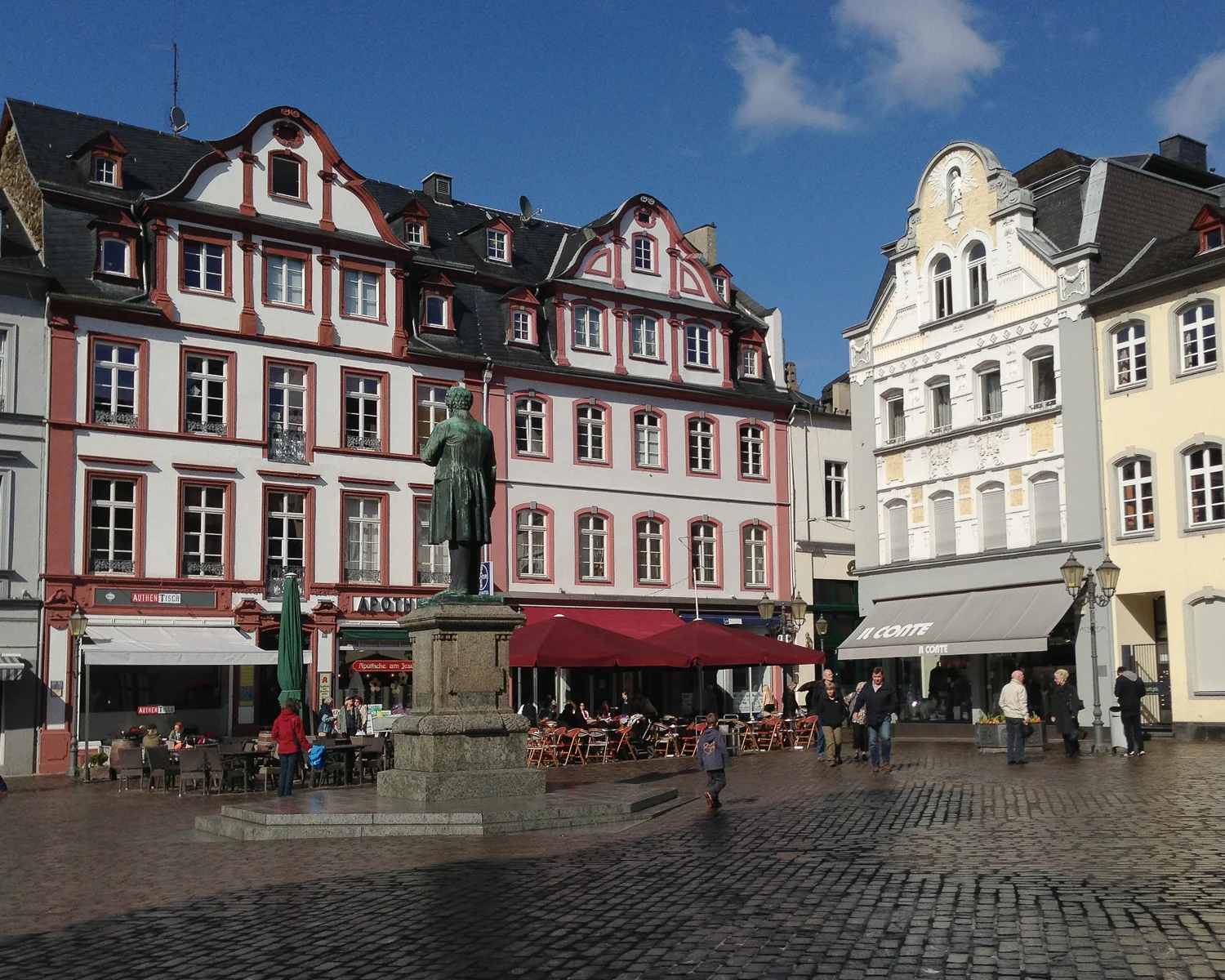
Our walking tour took us past the confluence of the rivers, where all the flags of the German states were flying, as well as an American Stars and Stripes that the Germans added in solidarity after the bombings of 9/11.
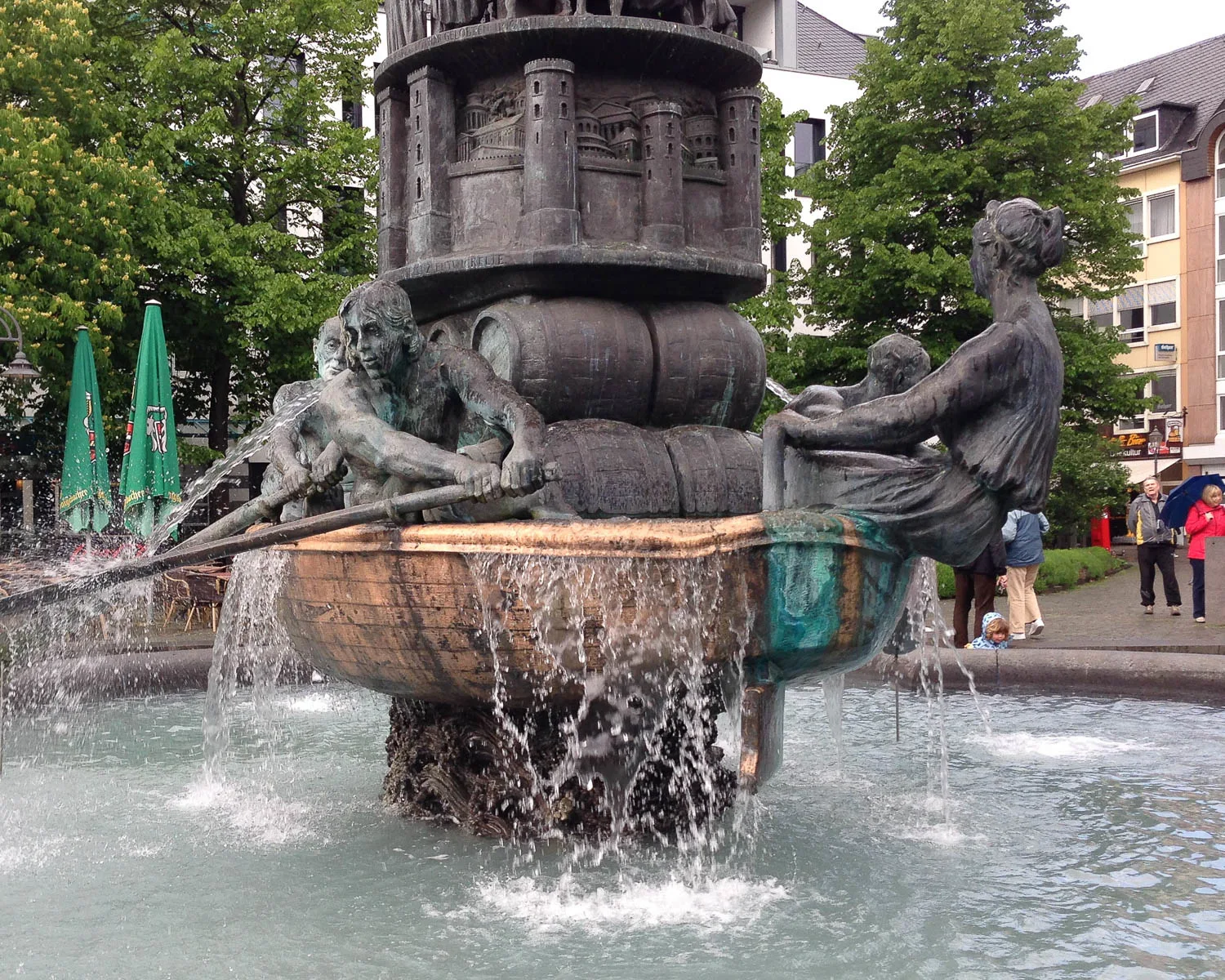
Beware of the famous statue in Koblenz of a young boy spitting, which soaks the unwary every few minutes if you stand in front of it. Our tour ended at 6pm under the church clock to watch the face that rolls its eyes and sticks out its tongue six times as the clock strikes.
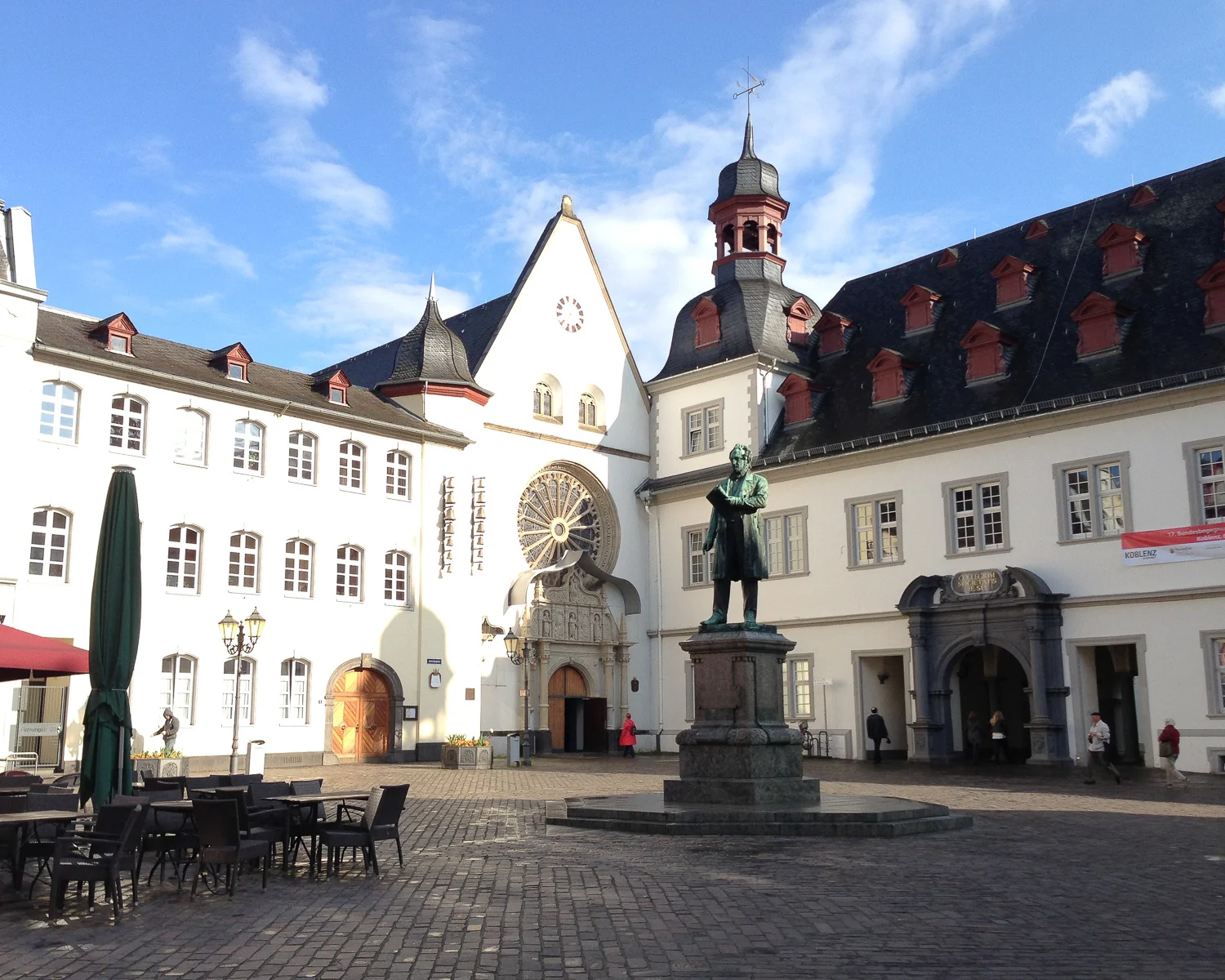
Day 5 – Cochem, Wine Tasting and a Cycle Ride
The Amadeus Princess takes a detour along the Mosel River to Cochem where we visited the picturesque Reichsburg Castle, learned about local wines and cycled be the river.
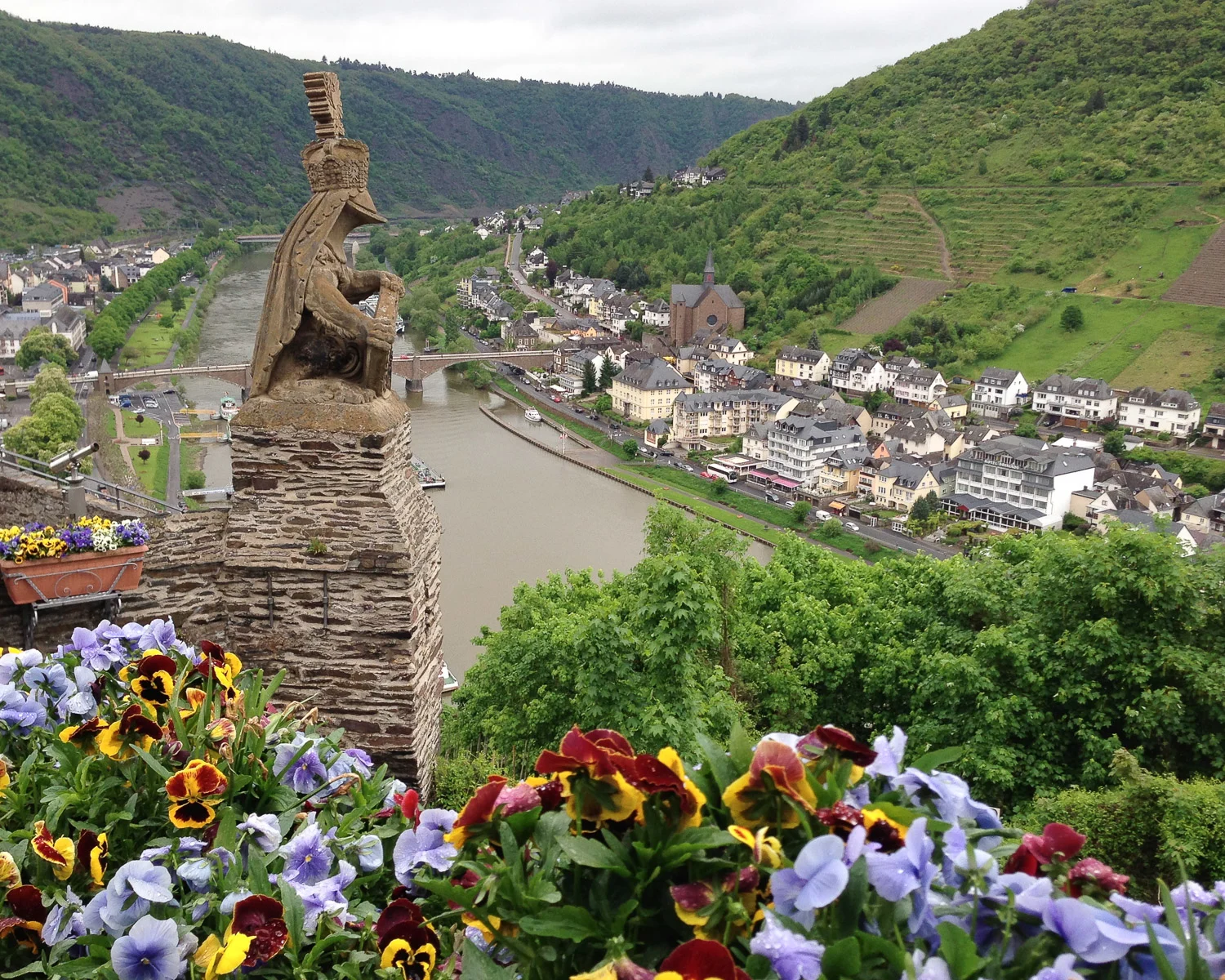
Cochem and Reichsburg Castle
Taking a detour from the Rhine, the Amadeus Princess headed up the Mosel river to the town of Cochem, overlooked by a picturesque castle on the hill. Although built in the 11th century, the Reichsburg castle was later given the fashionable romantic look of towers and turrets. It was restored in the 1860s by the wealthy German industrialist, Jacob Louis Ravené, who used it as a summer residence.
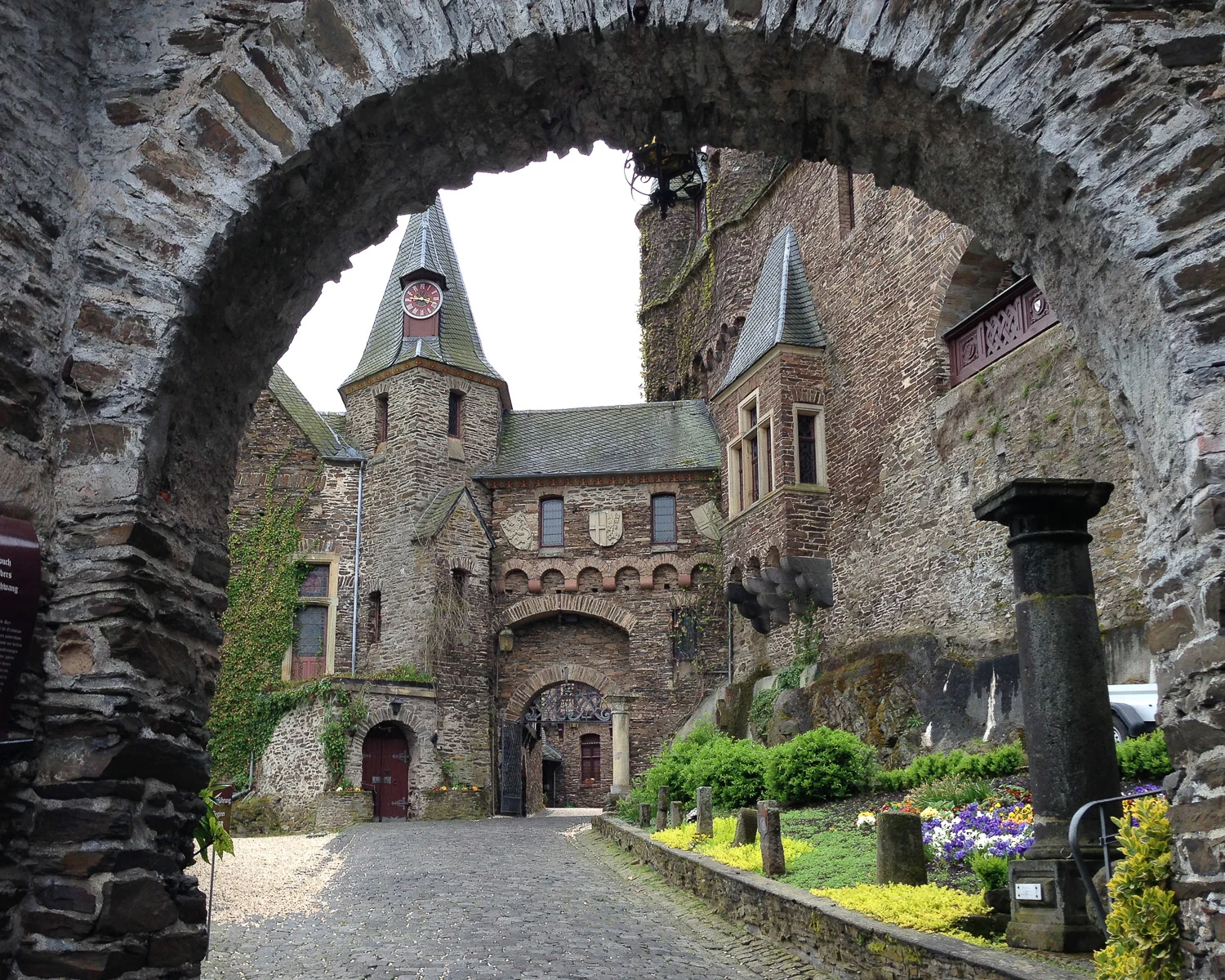
Millions of German marks were spent rebuilding and renovating the castle with the modern conveniences of electricity and running water, with decoration in romantic neo-gothic style. We enjoyed the intimate feel of the castle, with rich furnishings, suits of armour and colourful painted walls.
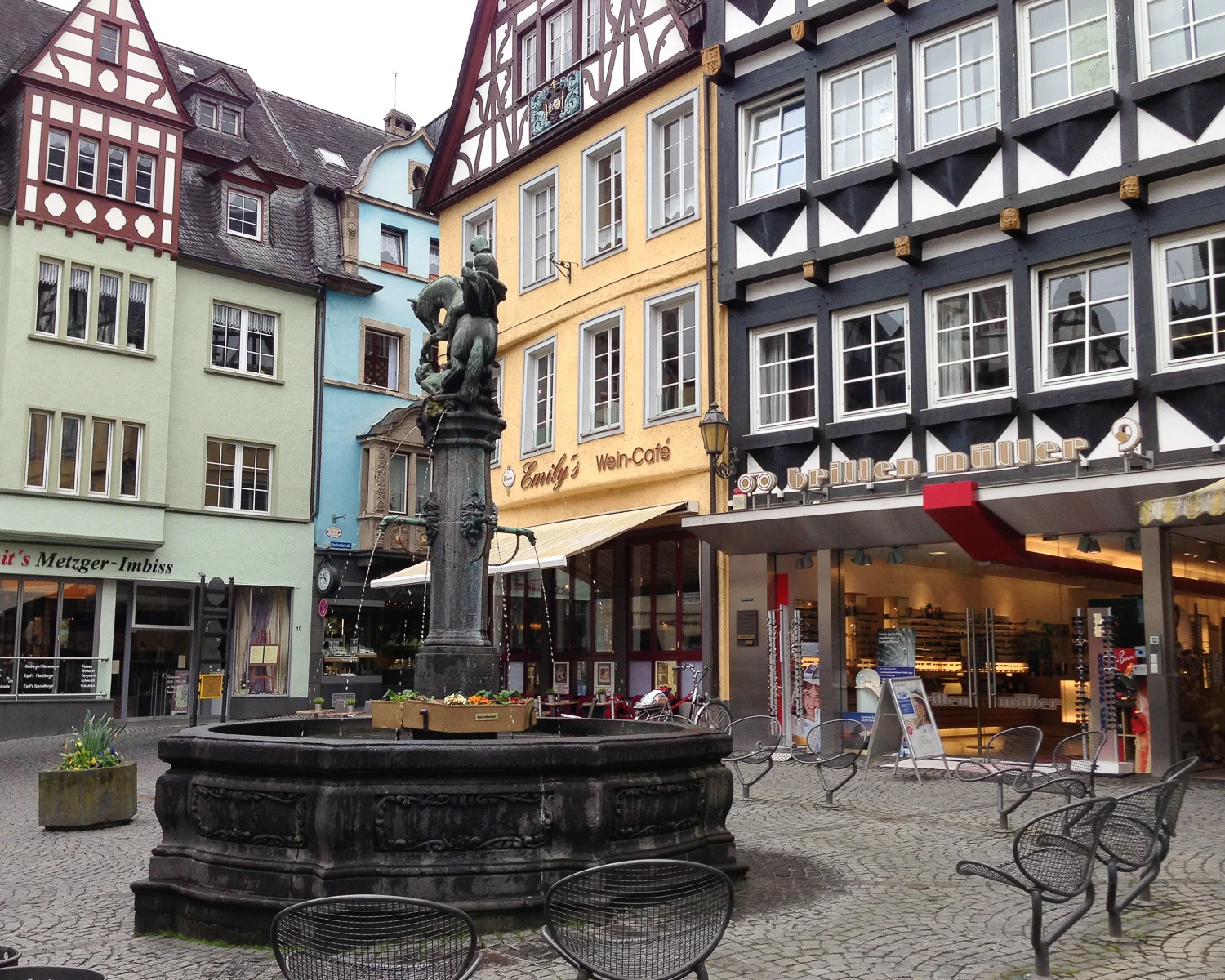
After our castle visit we walked down to the old town where narrow stone staircases lead down from the old monastery building above the town. Closer to the river we heard how the shops are sometimes flooded when the river rises. Businesses monitor the water level at Trier further up river and get sufficient warning to empty out all their goods before the flood hits Cochem.
Moselle wine tasting
Our tour finished with a wine tasting where we learned how the best vines of the Mosel region grow on south facing slopes. beneath the vines are beds of slate, which act like a radiator to help ripen the grapes.
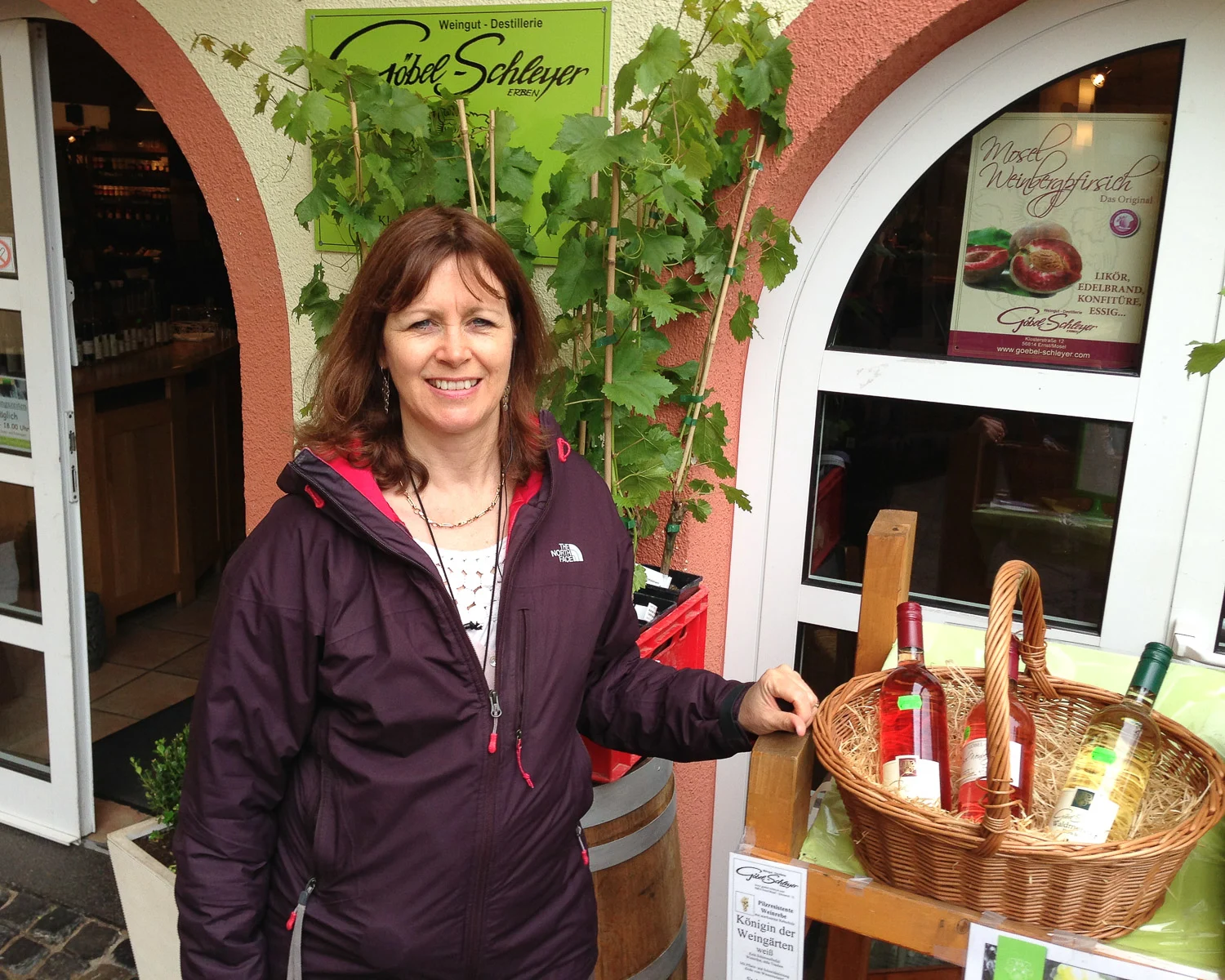
The Riesling grape is well suited to the damp, cool summers and requires a long growing season before being harvested by October. A special variety of red-fleshed peach is also grown in many vineyards and is used to make a peach liqueur that is delicious mixed with sparkling white wine to make a Kir Moselle.
A cycle ride beside the river
Continuing with the local food and wine theme, at lunch we enjoyed some seasonal fat white asparagus that we’d spotted in all the markets. As the ship was not due to sail until the evening, we took the opportunity to borrow bikes from the ship. A happy hour was spent cycling along the path beside the river with views of the old painted houses built hard up to the rock below the castle.
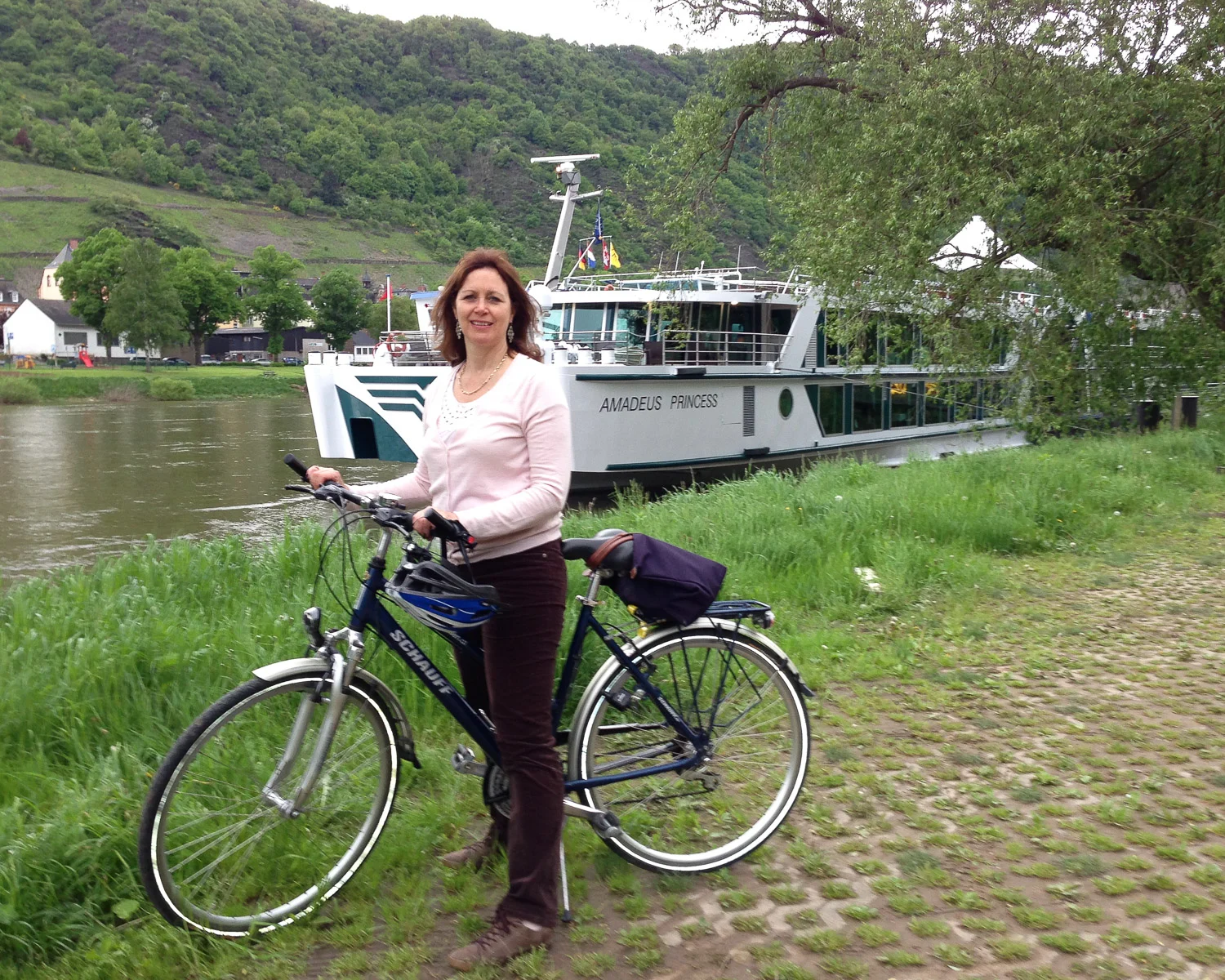
Day 6 – Our Rhine Cruise Ends at Cologne
We arrive at Cologne where we disembark, although the ship continues to Amsterdam.
Cologne Cathedral
On the final day of our Rhine river cruise with Lüftner Cruises, we woke up in Cologne, within a short walk of the city centre. This is where we were to disembark, but we still had a day of sightseeing, leaving our suitcases in an automated baggage store at the station.
At the heart of Cologne is the magnificent cathedral, that was one of the few buildings that remained standing in the Second World War. The twin spires have become the landmark of the city.
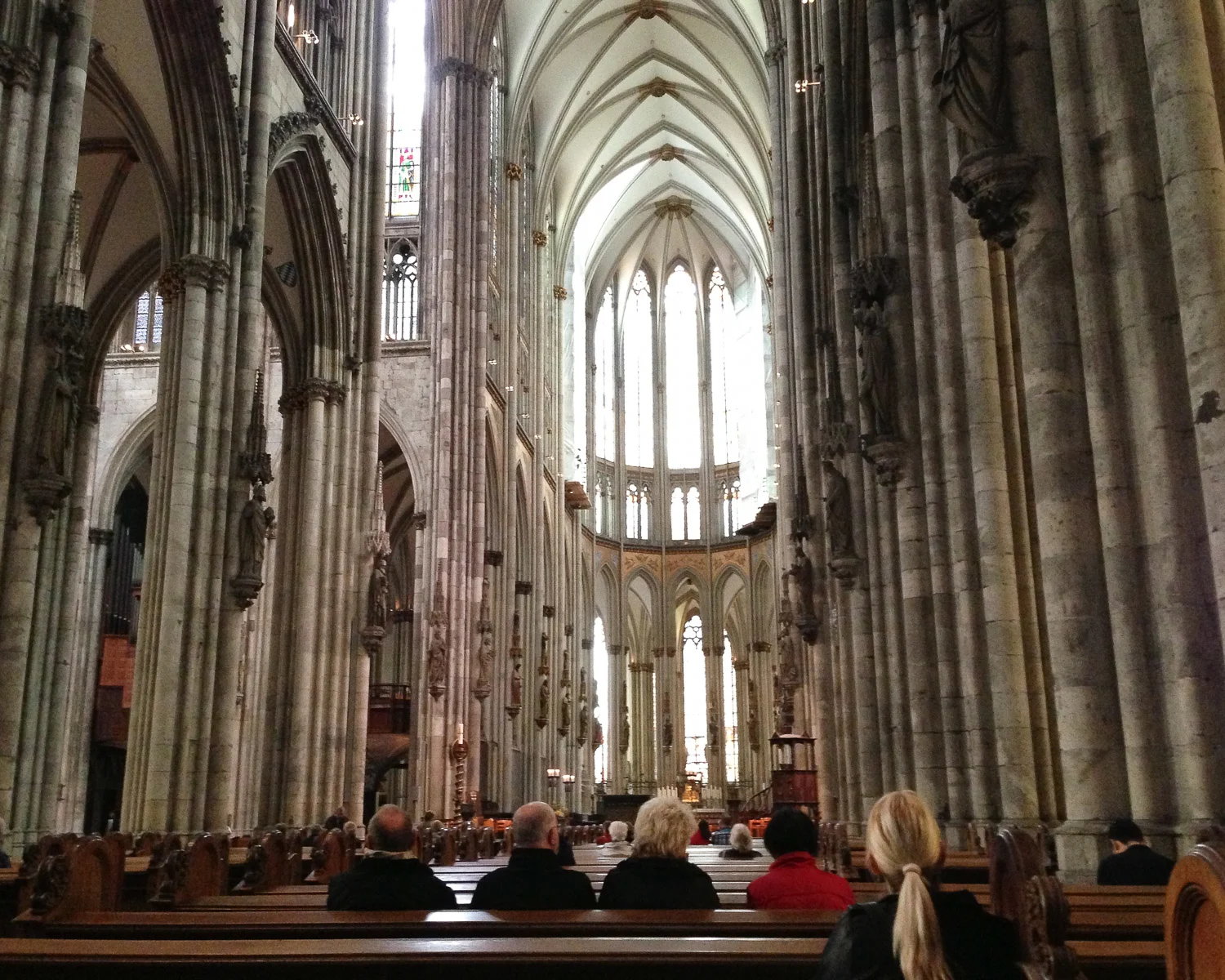
On the cruise we had an excellent guide for every place we visited, but now we were free to wander at our own pace with just a leaflet to explain the points of interest. The cathedral has many beautiful side chapels, colourful stained glass and precious altar decorations and we had time to see most things of interest, before the visitors were restricted in order to allow a time of prayer.
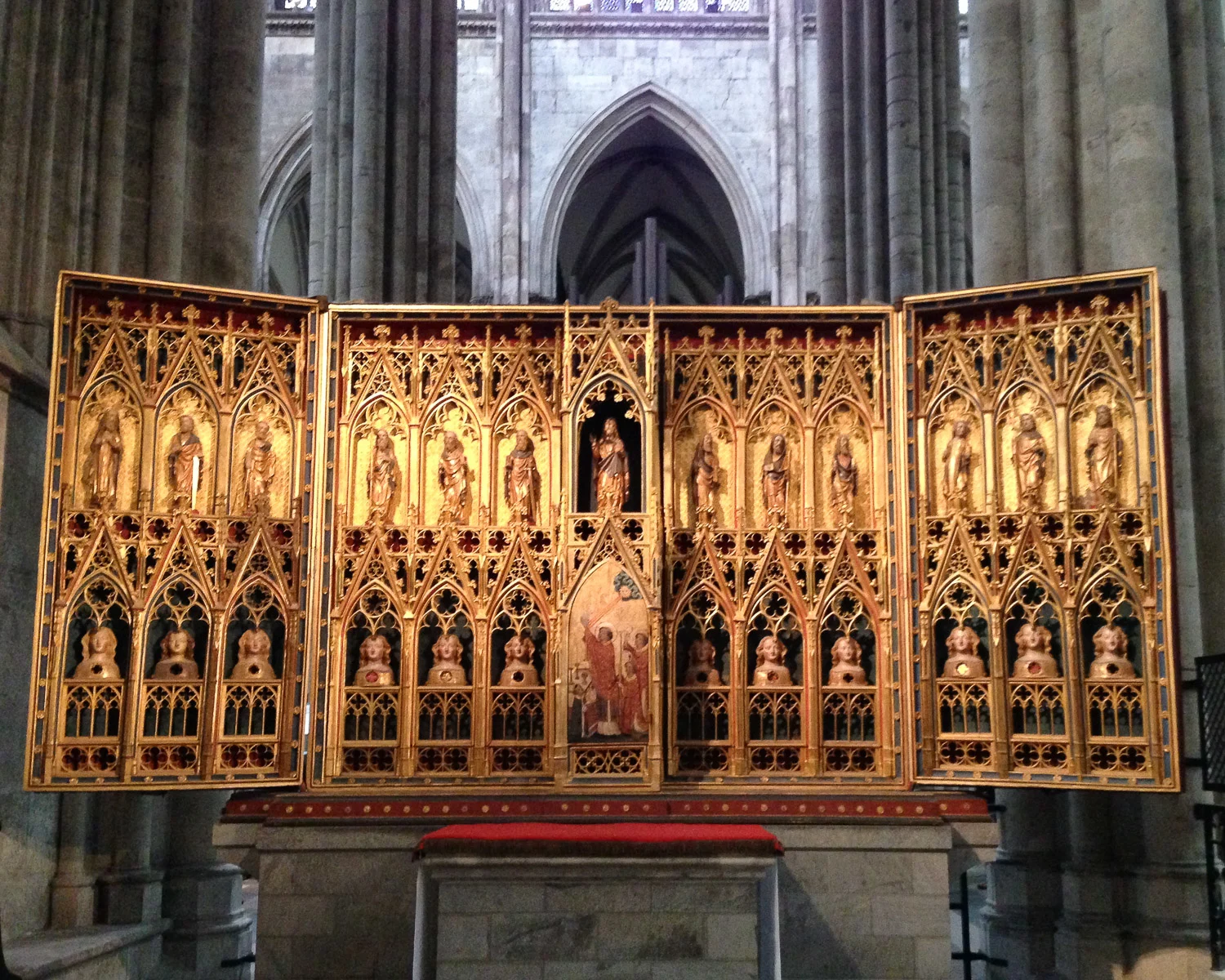
Lunch in Cologne
Although there were plenty of pleasant cafes along the river frontage, we decided on lunch at one of the many beer halls around the Heumarkt where a street market was just setting up. Despite the traditional appearance, our choice turned out to be an Italian restaurant and I ordered from their asparagus menu featuring several dishes using the local asparagus that was in season.
Cologne Chocolate Museum
With a couple of hours to spare, we walked to the chocolate museum on the banks of the Rhine, joining the crowds of teenagers and school children. In the museum we learned how the cacao beans are grown and chocolate made, and walked through a mini tropical greenhouse growing some of the cacao and other tropical plants.
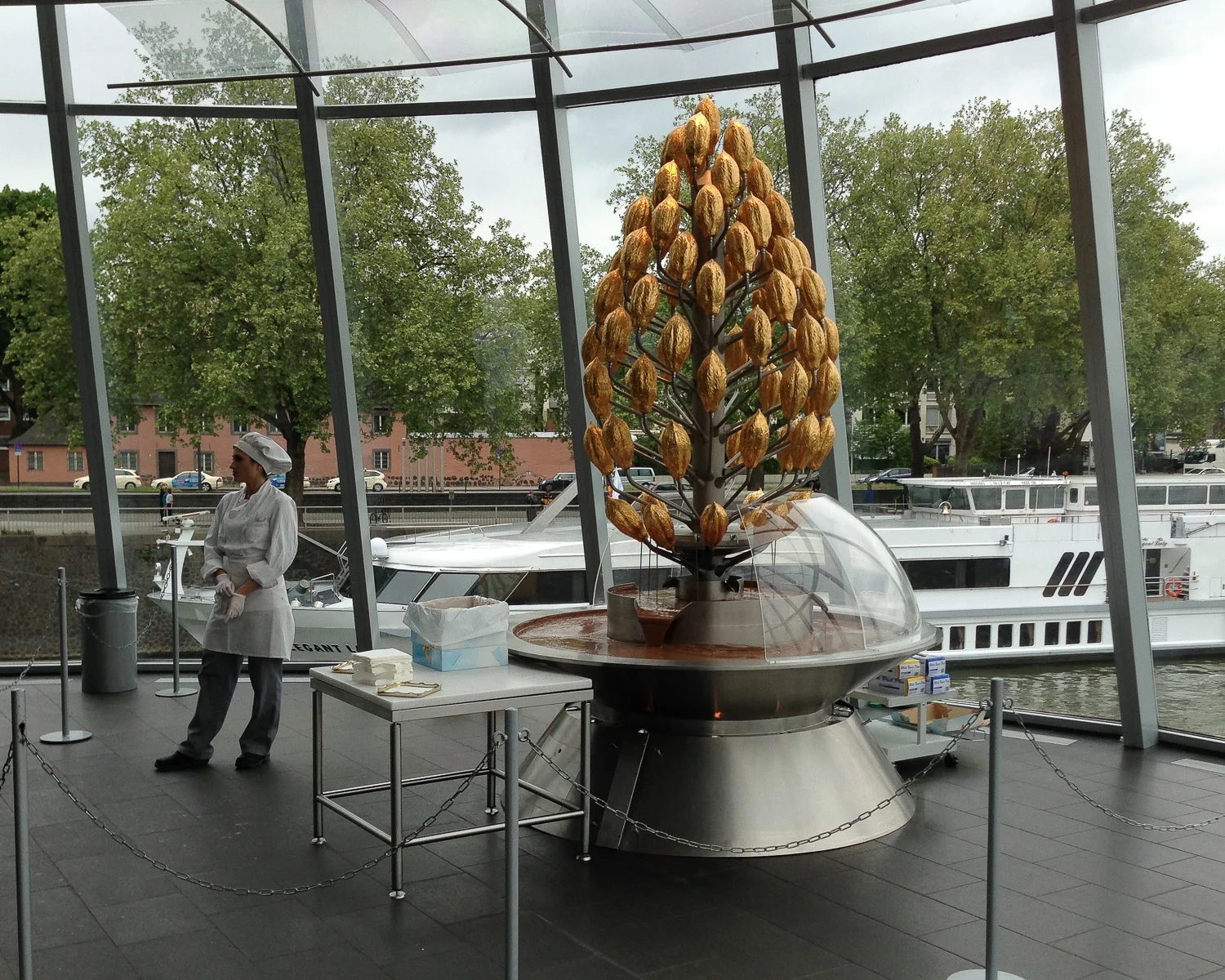
There was a large room of chocolate making machinery where we could see chocolate progressing from the melting stage, to being moulded and wrapped in foil, all on the same machine.
After a cup of hot chocolate and a slice of chocolate cake in the café with a view of the Rhine, we took a bicycle taxi from outside the museum back to the station where the train took us to the airport.
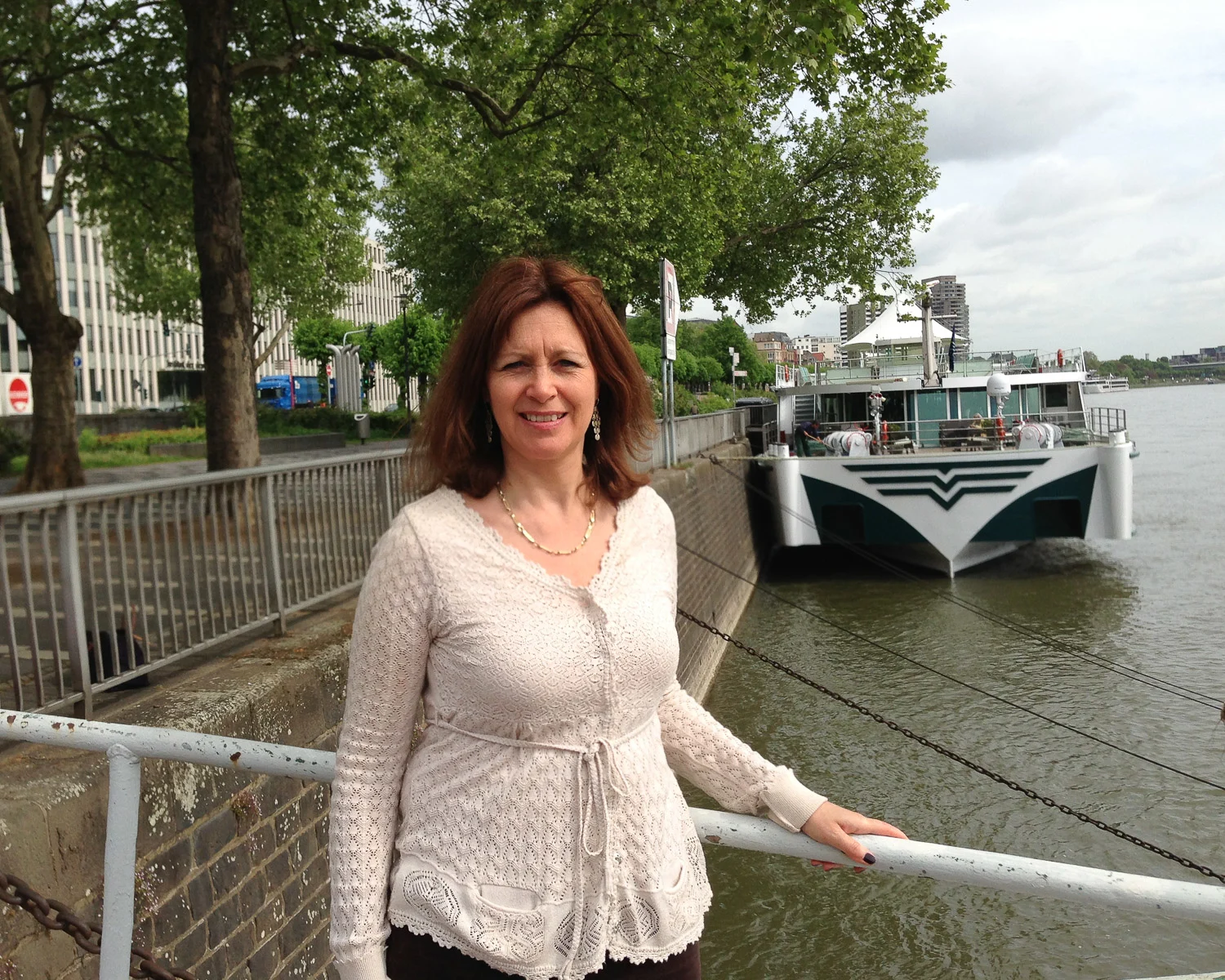
An end to our Rhine River Cruise
While we had to go home a little early, the Amadeus Princess was continuing for a further couple of days as far as Amsterdam. We left with great memories of our first cruise, finding it a very relaxing way to travel.
We had been able to dip into interesting riverside towns, each with its own story to tell, while enjoying a comfortable and luxurious base on the Amadeus Princess.
Listen to my podcast on the Rhine River cruise that we took, visiting pretty riverside towns, tasting local wines and l
Read Next
Listen to my Rhine River Cruise podcast – a week of history, wine and music
More Tales from my Rhine River Cruise
All aboard the Amadeus Princess – what to expect from your river cruise ship
Video – The Rudesheim Music Museum – Siegfried’s Mechanical Music Cabinet
From Riesling to Gewürztraminer – our wine tasting on the Alsace Wine Route
About Lüftner Cruises
Lüftner Cruises specialise in European river cruises on the Rhine, Danube, Rhône and other destinations in Europe, with personal service and Austrian hospitality. We travelled on the Amadeus Princess on a 7 day Classical Rhine Cruise which travelled from Basel to Amsterdam, although we disembarked at Cologne.
My thanks to Lüftner Cruises who hosted* our Rhine River Cruise.
* More info on my policies page
This article is originally published at Heatheronhertravels.com

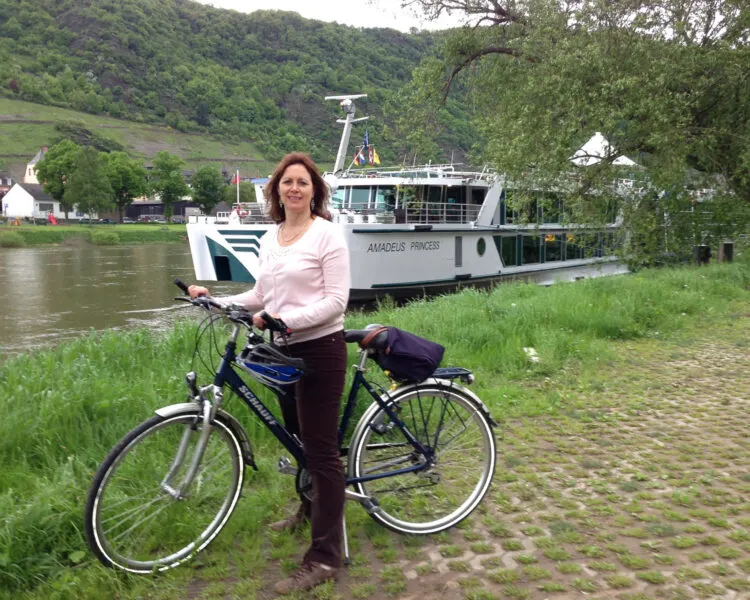

Julie Arnold
Monday 25th of May 2015
My husband and I took a winter cruise down the Rhine. It was the first time for both of us. We will be back. The ship and staff were excellent. I don't know how they can improve on perfection.
Heather Cowper
Monday 25th of May 2015
@Julie I'm so pleased that you had such a great experience
Lauren Meshkin
Tuesday 9th of July 2013
I've been wanting to take a river cruise ever since two summers ago when I saw several of them floating down the Danube River in Budapest. I think all of these posts have finally convinced me. Thanks! Looks like you had a fabulous time. I love all of the pictures.
Heather Cowper
Tuesday 9th of July 2013
@Lauren Yes, this was my first cruise but I'll definitely be back for more.